
13218307041
Did You Use Nature to Revitalize Before You Had a Baby?
Holly McGowan BSMA CNA AD
Let me be the bearer of some great news... There is no reason to stop.
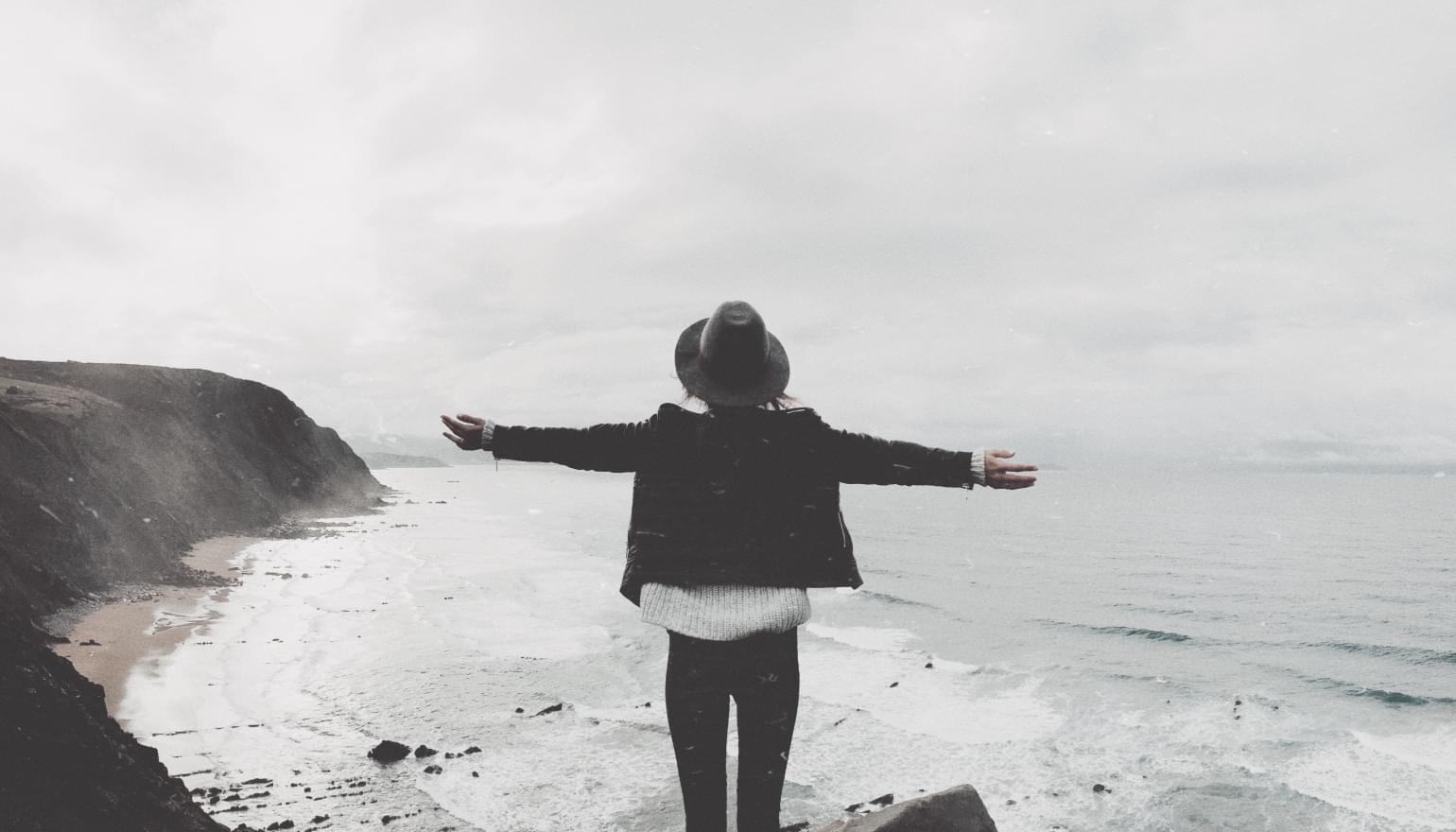
THE AMAZING BENEFITS OF SUNLIGHT FOR NEWBORN BABIES
(and your entire family)
Since vitamin D is vital for bone formation, exposure to sunlight is mandatory at all ages. For newborn babies, it helps in managing bilirubin levels if it is done in the first few weeks. Remember that you also need vitamin D as much as your baby does, so don’t hesitate to expose yourself to sunlight when doing so with your baby!
Being active outside brings out your child’s natural energy and curiosity. So it is worth all the time you can spare to help them discover their interests in a playful and joyful manner.”
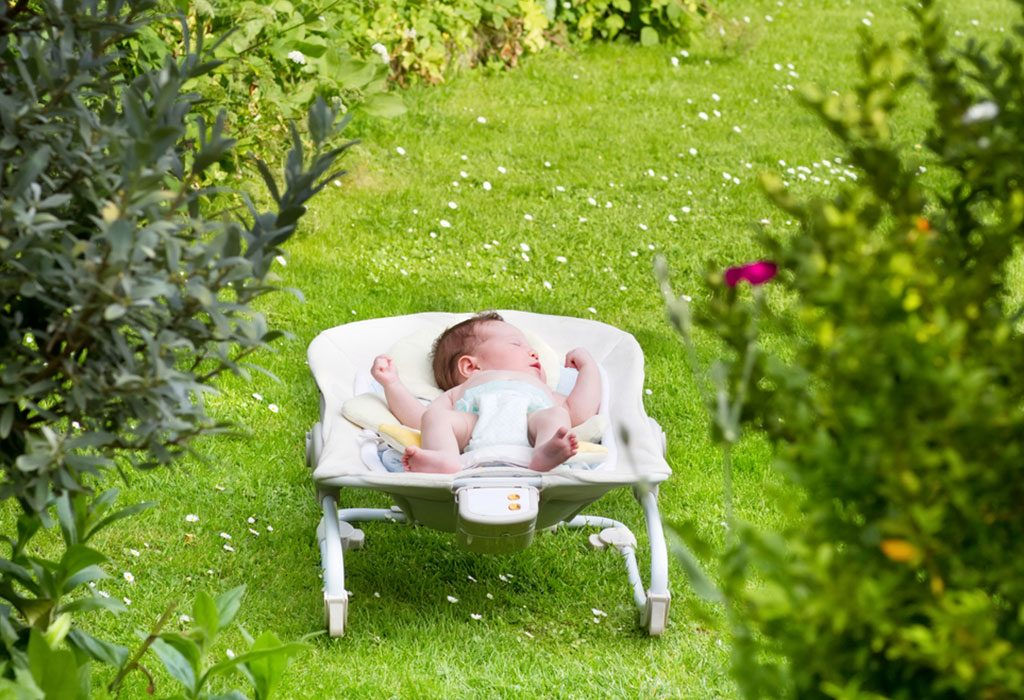
In this Article
Health Benefits of Sunlight for a Newborn
Tips to Gain Maximum Benefits From Sunlight for your Baby
A newborn baby’s sensitive skin needs to be protected from the harmful effects of the sun, including heat and moisture. Keeping your baby away from direct sunlight is a good idea, but exposing your little one to mild sunlight – especially in the morning – is beneficial in many ways. UV rays come with great health benefits when properly made use of for the baby.
“Loose parts explorations rev up your babies and toddlers in outdoor play. Loose parts and sensory exploration fit so well in free play or open ended in nature. However, make sure that you follow a few guidelines to make their play safe and fun.
Strollers, pack and plays, carriers, bassinetts, wagons,
AMAZING BENEFITS OF MILD MORNING SUNLIGHT FOR NEWBORN BABIES
(and your whole family)
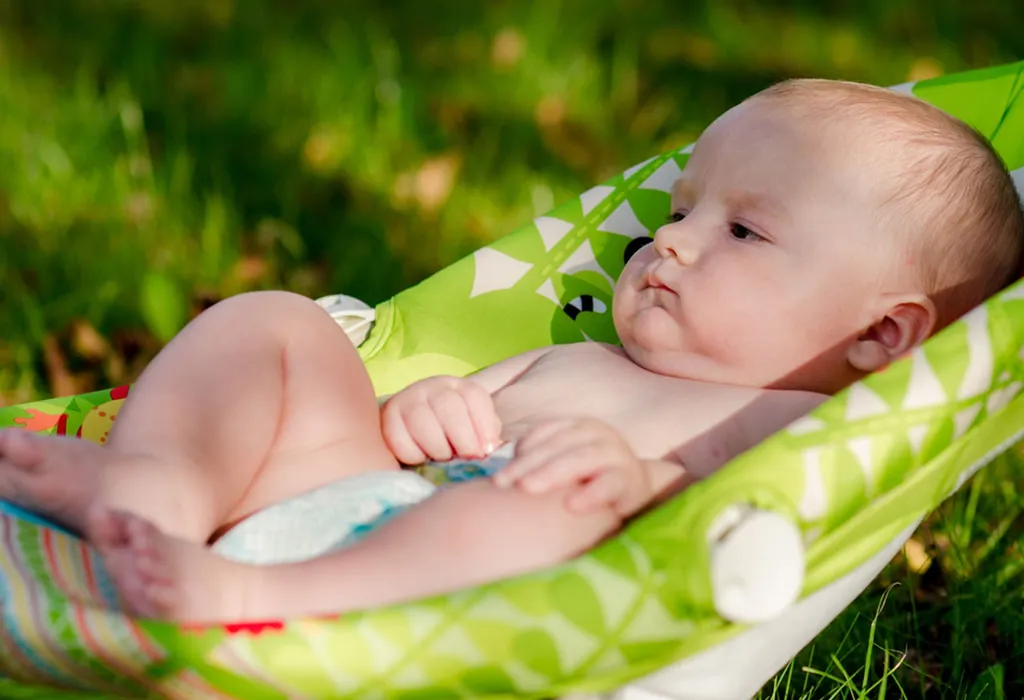
1. More Vitamin D:
This is one of the biggest benefits your baby will get on exposure to sunlight. Our body needs vitamin D; and to create it, the body requires a minimum of 15 minutes of UV rays every day, depending on the baby’s skin tone – darker-skinned babies require more time in the sun, but it should not exceed 30 minutes. Vitamin D aids in absorbing calcium, which in turn strengthens bones and teeth. The immune system works efficiently, and the body is protected from diseases.
2. Better Serotonin Levels:
Sunlight is known to augment the production of serotonin when babies receive it in the necessary quantity. Serotonin, which is often called the ‘happy hormone’, boosts the feeling of happiness and security. Serotonin regulates sleep and digestion in babies.
3. Enhanced Insulin Levels:
Receiving sunlight from an early age can help prevent conditions like diabetes to a certain extent. Though it is not the only facilitator of good insulin levels, it is definitely an added advantage as the vitamin D in the body helps manage insulin levels. A healthy diet and exercise during the child’s growing years can be extremely beneficial in keeping diabetes in check.
4. Manages Jaundice or Yellowing of the Skin:
Sunlight helps break down bilirubin – a yellowish compound that occurs in the natural catabolic pathway – so that a baby’s liver can process it more easily. The unchecked growth of bilirubin can cause the yellowing of a newborn baby’s skin. Exposing your baby to morning sunlight for 15 to 20 minutes, undressed, every day, can help with mild jaundice. A severe case, however, will need more attention.
5. Higher Energy Levels:
When a newborn baby is exposed to natural sunlight, it helps regulate the production of melatonin. Melatonin levels in the baby can impact his sleep patterns, which are of utmost importance in the newborn’s early years. Sunlight causes a dip in melatonin levels and increases serotonin, thus increasing energy levels.
TIPS TO GAIN MAXIMUM BENEFITS FROM SUNLIGHT
FOR YOUR BABY
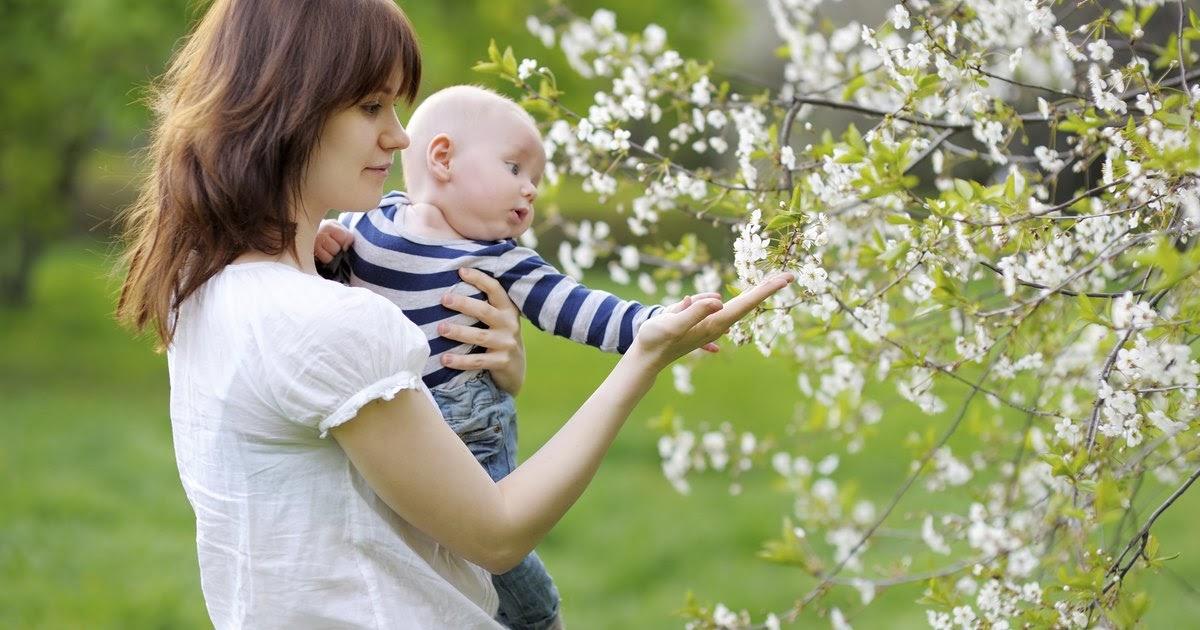
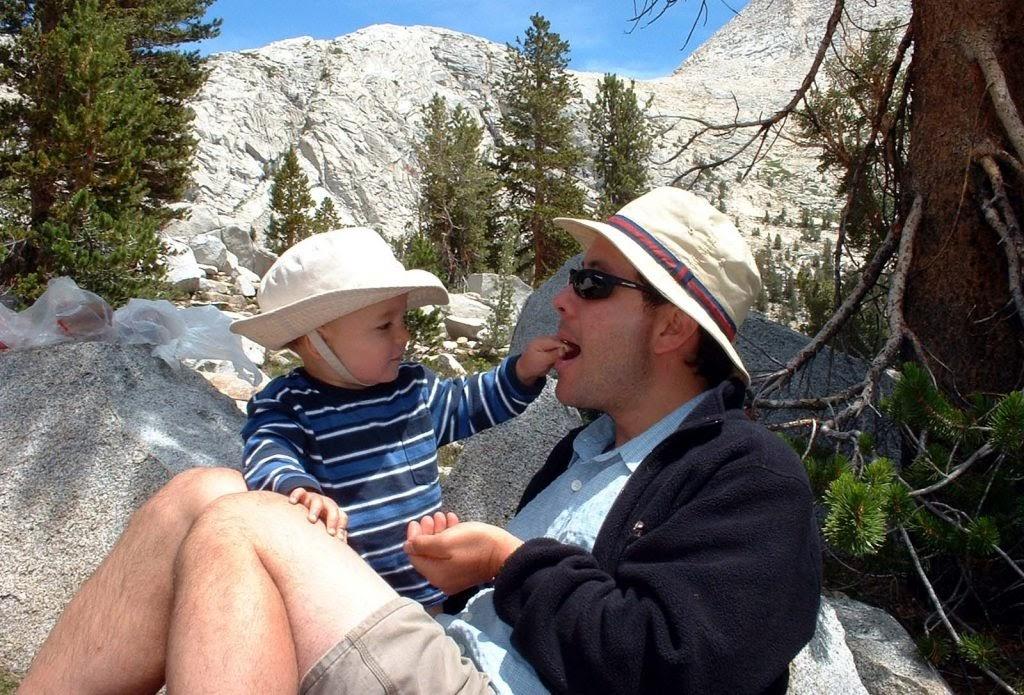
A 2017 study conducted by University College of Medical Sciences, New Delhi showed that exposing babies regularly to sunlight has the ability to give them sufficient vitamin D levels to keep them healthy. The study found that exposing a baby as young as 6 weeks for around 30 minutes a week can give him adequate vitamin D levels to aid in his optimal growth and development. Research also suggests that exposing even 40% of the baby’s body to sunlight can do the trick. However, interestingly, the study showed that the ideal time for a sunbath for the baby is between 10 am and 3 pm!
Ours is a tropical country, so sunlight is aplenty – if you live in a fairly cooler climate, the above-mentioned time can be considered. However, if you live in a place that is generally warm, consider the more popularly accepted timings of 7 am to 10 am to expose your little one to sunlight. Just remember this simple rule of thumb: The larger the surface area of the body exposed, the better it is for your baby.
Now that you know newborns and sunlight share a therapeutic relationship, here are a few tips to maximize its benefits:
1. Pick the Right Time:
Make sure your baby is exposed to sunlight for 10 to 15 minutes between 7 and 10 am to draw maximum benefits. An hour after sunrise and an hour prior to sunset is considered the best time to expose your baby to sunlight. Since the baby’s skin is sensitive, exposure to sunlight should not exceed 30 minutes. Prolonged exposure to UV rays can damage your baby’s skin membrane, causing redness, burning, and irritation.
2. Use Minimum Clothing:
It is important that the baby’s entire body, including the chest and back, receives equal attention. So, ensure that your child isn’t fully clothed. Shield your little one’s eyes if possible to avoid any chances of damage.
3. Choose the Right Location:
It is not necessary that your baby’s sunbathing is carried out in a completely open space. Open a window that can stream sunlight in, or place the baby in the room with natural sunlight. If it is windy, it is best to keep the baby indoors to avoid dust or other foreign bodies from affecting his eyes. Your baby can bask in the sunlight through a clear glass window just as well.
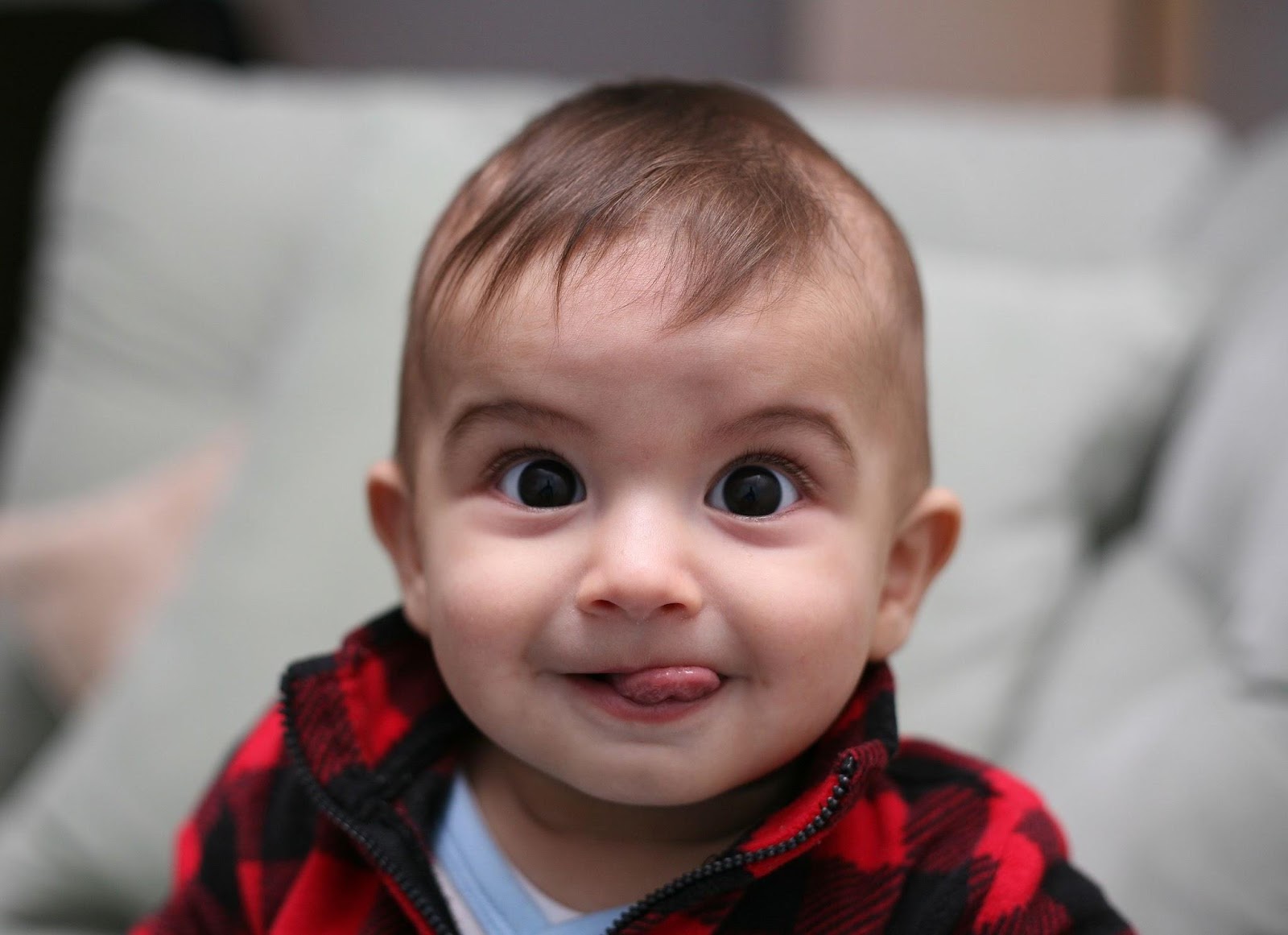
4. Premature Babies Need Attention:
In case your baby is premature, do not expose him to sunlight during the initial few weeks. The baby may not be able to adjust to the warm temperature, and this could prove unsafe for him. Preterm babies need a stable body temperature, and thus should be kept away from direct sunlight in the initial period. Babies within a healthy weight range can be placed near a clear window.
5. Sensitive Skin Needs Care:
If your baby has sensitive skin, check with your doctor if it is ok to expose him to direct sunlight. Otherwise, you may damage the baby’s skin as it could dry the skin, leading to rashes, peeling or general irritation.
6. There Are No Age Barriers to Sunbathing:
Since vitamin D is vital for bone formation, exposure to sunlight is mandatory at all ages. For newborn babies, it helps in managing bilirubin levels if it is done in the first few weeks. Remember that you also need vitamin D as much as your baby does, so don’t hesitate to expose yourself to sunlight when doing so with your baby!
7. Pre-Bath Cleaning Can Be Detailed:
Your baby can receive his daily dose of sunlight before he has his bath. This will help you to clean areas that are overlooked, like the folds of the stomach, thighs, feet, and areas behind the ears.
8. Watch Body Temperature:
Any abnormal increase in the baby’s body temperature due to prolonged exposure to sunlight should be a cause for concern. The baby’s body and brain function can be affected by high temperatures, so the duration and temperature have to be monitored carefully.
9. Use Time Wisely:
While your baby is enjoying his time in the soft sunlight, you can use this opportunity to connect with the baby. You can massage the baby lightly with baby oil to give him additional protection against skin problems. Caressing the baby creates a feeling of security and warmth, and promotes good health. Make sure you speak to the baby the entire time and build a foundation for future communication between you and him. This well-utilized time has many physical and emotional benefits for both the baby and the mother.

Now that you understand the powerful physical and emotional benefits of sunlight exposure for your little one, it is time to take action! You will have to consider your baby’s skin condition and general health before you do so. Make sure you join your baby for this glorious exercise whenever possible. Sunlight is available in abundance for most of us, and we should utilise it to the maximum for health-related benefits.
NEWBORN SUN PROTECTION GEAR ESSENTIALS
Disclosure: I am a Green Sprouts partner. All opinions expressed are my own.
True story: About a month ago I was up in the middle of the night feeding Jack and scrolling Facebook when I stumbled upon a post in one of the essential oils groups I’m part of. This particular post made my jaw drop.
A woman in the group actually claimed that she puts her weeks-old baby in the sun each day to “boost its immunity to the sun so it won’t need sunscreen.”
I’m not an expert, but I’m fairly confident when I say that’s not how that works.
While the “wisdom” this lady was handing out wasn’t for me, it did get me thinking about how best to protect baby Jack as we head into the summer months in the southern United States.
The American Academy of Pediatrics recommends that babies younger than 6 months should be kept out of direct sunlight and dressed in lightweight clothing that covers their arms and legs and a brimmed hat that shades the neck to prevent sunburn.
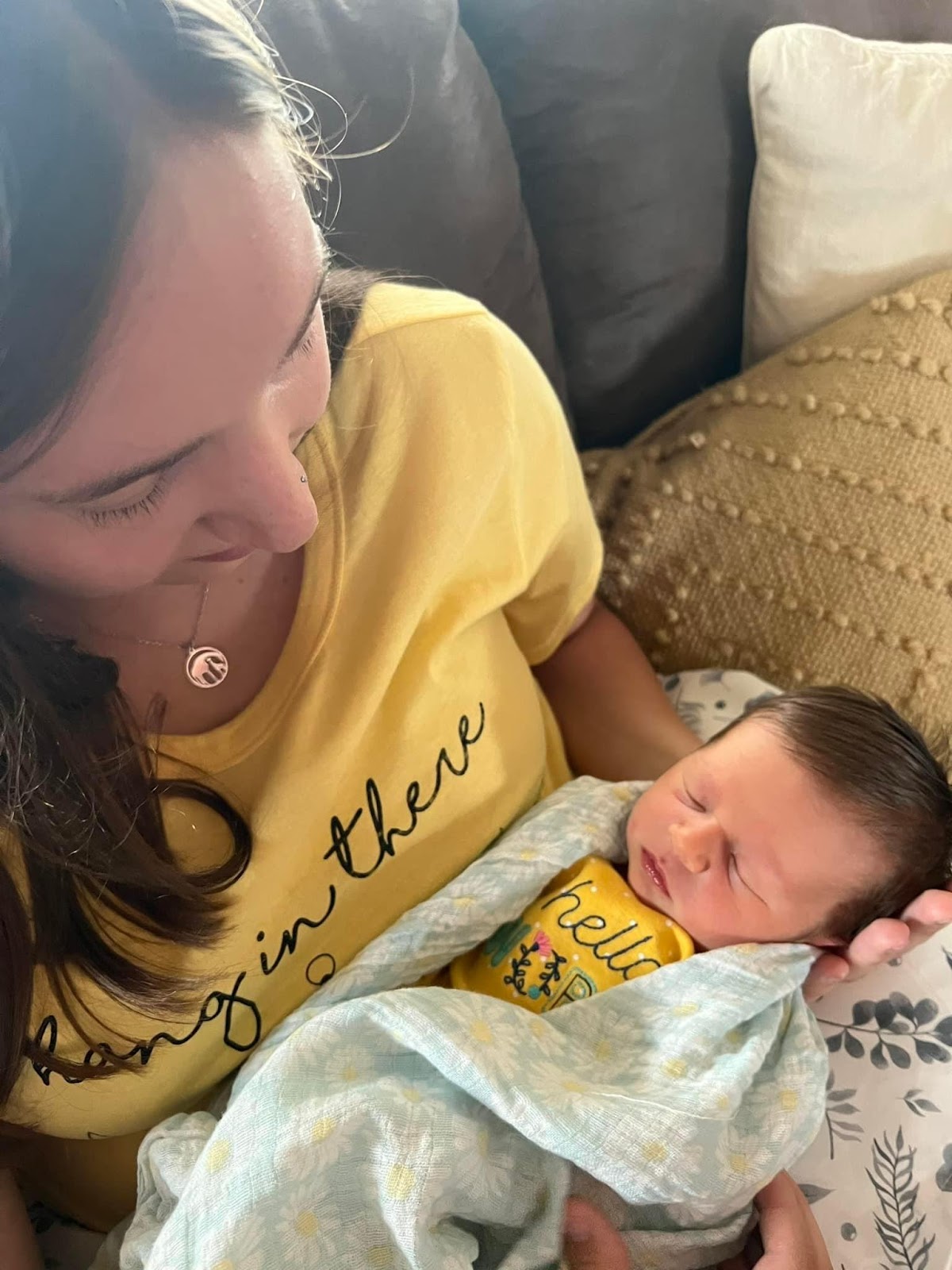
When adequate clothing and shade are not available, parents can apply a minimal amount of sunscreen with at least 15 SPF (sun protection factor) on infants under 6 months to small areas, such as the infant’s face and the back of the hands. Remember it takes 30 minutes to be effective.” American Academy of Pediatrics
I have also read that many pediatricians discourage the use of sunscreen on infants younger than 6 months altogether. Personally, I’m not comfortable putting sunscreen on my infant; not even clean, mineral sunscreens made specifically for babies.
We plan to spend a lot of time at the beach and the pool this summer and protecting Jack from the sun is top priority.
So, I started researching ways to keep Jack safe in the sun that don’t include sunscreen.
Obviously, keeping him in the shade is the best option and we plan to invest in a beach tent for him. We can also protect him with what he wears when he’s in the sun, though.
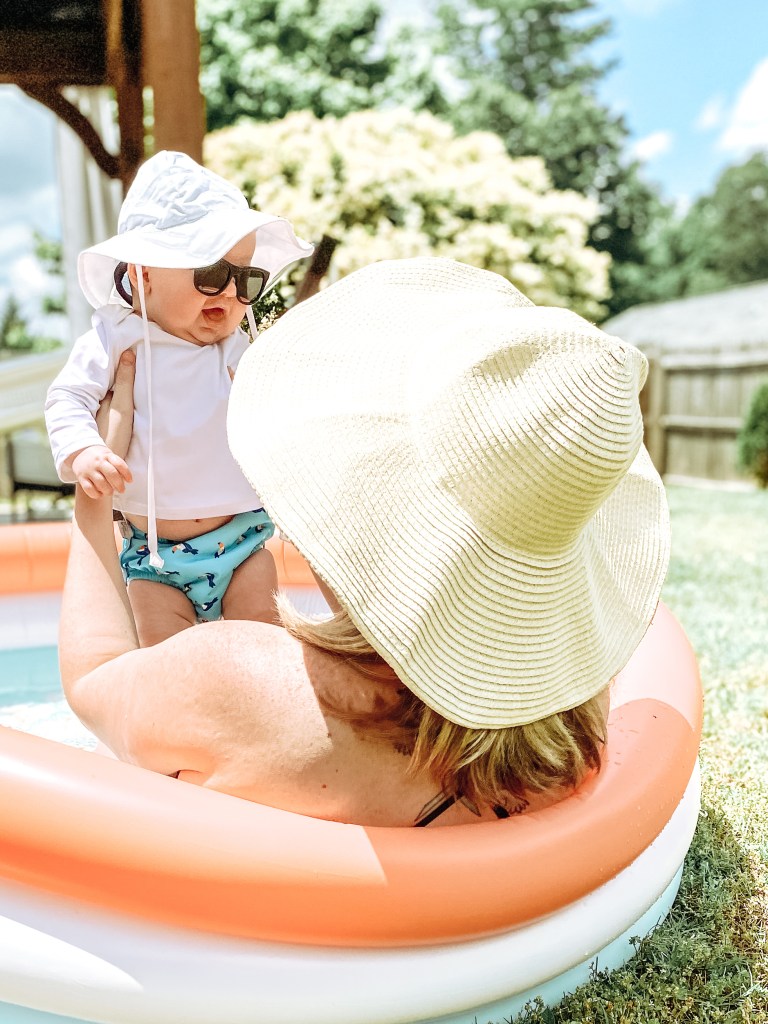
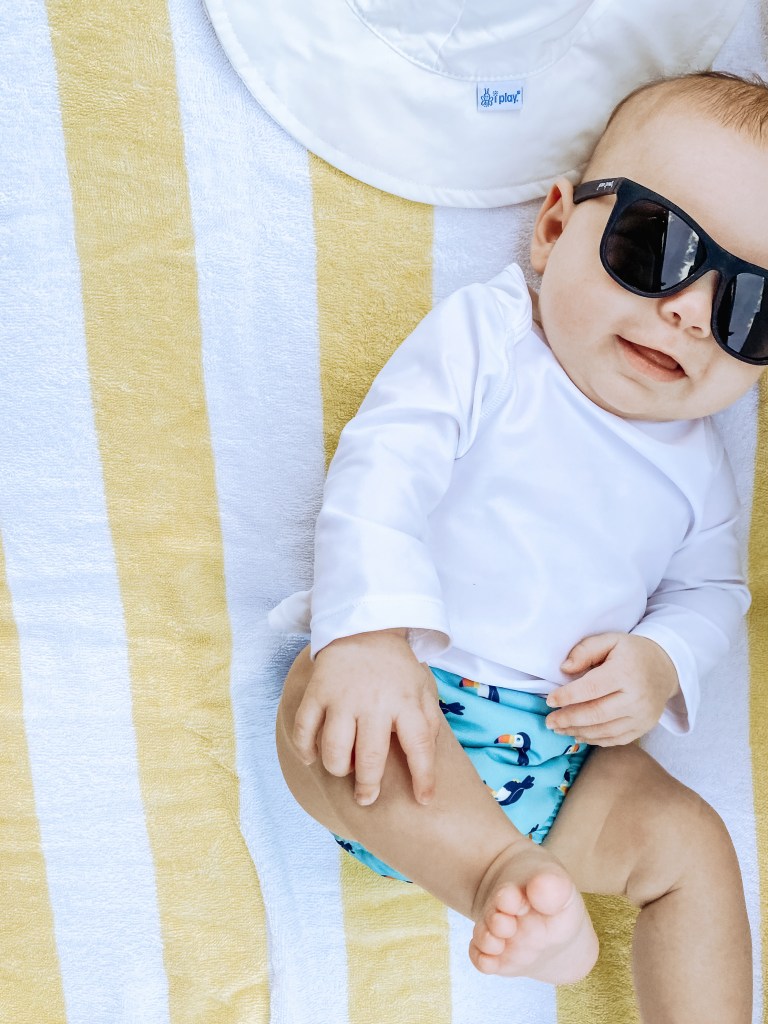
After a little digging, I found the most adorable sun protection gear and swimwear for babies and toddlers made by Green Sprouts.
To protect his little head, I ordered Jack the Green Sprouts bucket hat in white. It is made with UPF 50+ protection and the floppy brim covers his face, neck, and ears. I love that it is lightweight and dries quickly so that he stays comfortable in it. He isn’t bothered by it on his head, either!
I also ordered him their easy-on rash guard shirt. It is made with UPF 50+ protection, as well, and completely covers his arms, chest, shoulders, and belly. Plus, the shoulder design makes it easy to put on and take off.
The reusable swim diapers might be my favorite, though. I love that these are absorbent and waterproof and don’t require another diaper. They’re super soft, too, and come in a variety of prints and colors. We tested it out in our inflatable kiddie pool last weekend and it worked like a dream! Like our hat and rash guard shirt, the swim diaper features UPF 50+, too.
I do recommend sizing up in the swim diaper if your baby has chunky legs like our guy. Right now Jack is just shy of 4 months and the size 6 month diaper is a little snug.
The final piece of sun protective gear I ordered for Jack are these flexible sunglasses. Surprisingly, he keeps them on his face really well. They are made with 100 percent UVA/UVB sun protection.
Everything I bought from Green Sprouts has been comfortable for Jack, lightweight, and it dries fast (which is important if he’s going to be wearing it all day in the sun and water.)
How to Plan a Nature Date With Kids
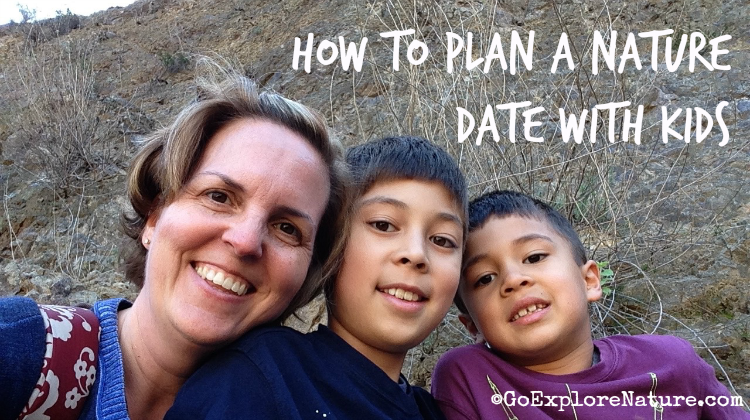
One of the items on my list of 12 resolutions for getting outside is scheduling a date in nature with your kids. If your kids are still very young or you play outdoors a lot anyway, these one-on-one experiences may seem unnecessary.
But trust me. They are very necessary.
I try to do something special outside with each of the kids separately once a week – even it’s just a walk around the block or a trip to the park. This is our time to connect not only with each other, but also with the world around us.
While some of these adventures are purely spontaneous, others require a little more planning. In either case, here are a few things I’ve found to help make the most of your special time together. (Truth be told, many of our adventures in nature are as a threesome, but the advice here holds true just the same.)
Make a date.
Decide on a good day and time for both you and your child – something that works with any of your current obligations. Make your nature date a priority by adding it to the calendar. You don’t need to carve out a ton of time; what’s most important is getting outside together.
Choose the right adventure.
Is there something your nature explorer especially enjoys – maybe hunting for bugs, skipping rocks or climbing trees?
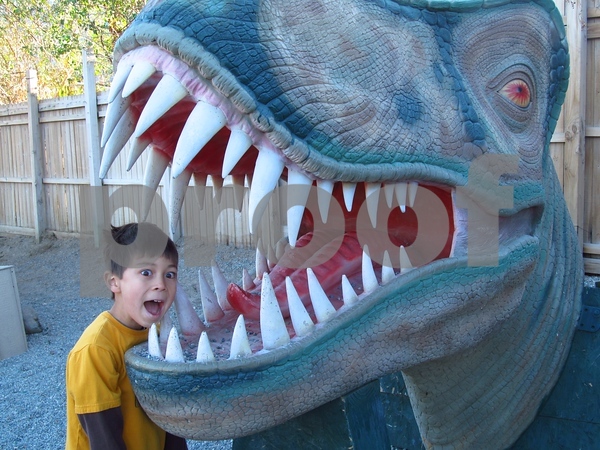
You don’t have to go anywhere grand or far away. It’s more important that you do something fun than that you get overzealous in the planning.
Talk it up.
Once you’ve set a date and decided on an activity, make sure your child knows about it. This makes the date extra-special; something to look forward to. Depending on where you go, you might even read related books ahead of time about your upcoming adventure.
Do a little prep work.
If we’re going anywhere beyond our backyard or a walk around the neighborhood, I bring along our adventure bag. In it, I carry a change of clothes (along with weather-appropriate gear like hats, gloves, jackets, boots), snacks or a picnic, water, sunscreen, a camera, notepad and pen, field guides and whatever else we might need.
Welcome the rabbit trails...follow their interests rather than your objectives
You’ve picked a great place to explore and maybe even something special to do while you’re there. But guess what? Your child has an entirely different idea.
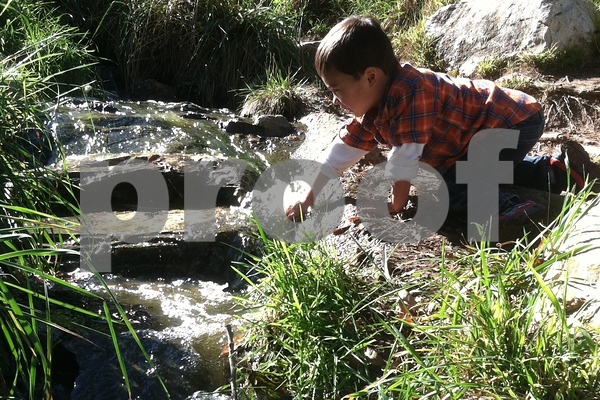
Like chasing butterflies instead of going on a scavenger hunt. Or wanting to skip a hike in favor of geocaching. What to do? Go with it. These are the moments you can’t plan. And the ones you won’t forget. Be joyful in the moment. And connect.
Have fun!
Really, this should be Rule No. 1. Have fun, be silly and laugh. A lot. Let loose and play like a kid. When you do, you won’t just connect with your child. You’ll remember what it’s like to be a kid again. And I promise you won’t be disappointed.

Flowers, plants, and animals provide your little one with rich learning opportunities.
From the first hour of life, when a baby stares into the eyes of his new parents, he is learning all about this brave new world. Babies try to make sense of what they see, touch, taste, grab, hear, hold, and squeeze. Think of a baby clutching a hunk of ripe banana, slowly squeezing it, and watching in wonder as the yellow, creamy fruit slithers between his fingers.
Babies are born primed to learn how the world of people and objects works. That is why they love exploring their outdoor surroundings. Every bug, animal, or bird that your baby sees is a brand-new experience — especially because babies spend so much time indoors. When at the park or in your yard, don't be surprised if your baby wants to touch a nice earthworm as she inspects the grass at the edge of her blanket. Many babies love to feel a caterpillar crawling on their arms.
Natural experiences should come in doses that are understandable for your baby and in ways that keep your baby safe, of course. Babies are forever exploring, whether trying to poke a finger into an electrical socket or attempting to tip over a stand so that they can pull at and maybe taste the shiny green leaves of a plant.
Babies are often unaware of dangers, and toddlers can climb with agility and fearlessness into hazardous situations. Be aware of the way your baby or toddler thinks. You might have a very gentle cat, but many a young toddler has pulled a cat's tail and received a strong scratch from the indignant cat! Social skills, such as decentering (taking the point of view of another) to consider the feelings of a peer or a kitty, are in short supply in infancy.
You might be surprised at how encounters in nature bring out a toddler's gentleness. Some will cry if you squash a Japanese beetle underfoot after you've seen the damage that beetle did to your rosebush leaves. Others will cry and protest if you clip the driveway bushes that are overhanging and scratching your car. Little children believe that moving things are alive. The bushes move and dance with the wind; your toddler thinks that maybe they are alive just as he is alive. Little children need a long time to learn about living and about death.
Opportunities to experience nature up close stimulate infant senses, provide loveliness for him to appreciate, and encourage you to label objects — flowers, plants, and animals — and to explain their characteristics. The following suggestions provide great ways for you and your child to safely experience the outdoors and will lead to rich learning experiences.
Observe animals in their natural habitat.
As you walk with your baby in a pack on your back, point out sounds she can listen to, such as a bird chirping or crow cawing at the top of a tree. Point out the insects crawling, the doggies running around sniffing, and the squirrels climbing up trees. As your baby begins to use some language, she may call your attention to a bird flying up and settling on a tree branch. Rejoice with her excitement. The world of animals and birds is a new kind of discovery for her.
Encourage touching.
In the park, you can introduce your baby to a great variety of nature's textures. Invite him to feel the grass and pinecones; to touch smooth, bumpy, and grainy textures.
Talk about the weather.
Lure your little one to a window to notice light raindrops, driving rain, and the way thunder rolls and booms after you see a jagged lightning streak. Encourage her to listen to the wind make its howling noises as it rushes by. If there is a rainbow, take your toddler outside to see this awesome arc in the sky. As your child spends time outdoors, she will become a better observer of nature, including of weather patterns.
Your child might whine if she can't go out to play due to bad weather, but if you point out different patterns — of rain, lightning, hail, or hot sun — to your little one and explain that sometimes playing outside is not safe, then your child will be aware of the weather rather than think you are making up an arbitrary excuse about why she cannot go out.
Visit the zoo.
Wheel your stroller close to an exhibit and point out what your baby is looking at, whether it's a seal splashing in the water or a monkey swinging from a branch. You have been reading animal stories to your little one from early on. Now, at the zoo, he gets to see all those creatures that were in the storybooks. Let your toddler tell you that he is watching Horton the elephant lift up his trunk!
Stroll through a garden.
Flowers and plants offer your baby sensory and aesthetic pleasures. She will be sensitive to, and admiring of, the colors, sights, and sounds. Trees, flowers, and plants provide opportunities for talking about rough bark, delicate blossoms, and perfume smells. Some flowers are lovely to look at but don't have a smell when you sniff them. You can also pick up your baby to show her a butterfly nosing about to get nectar. (A butterfly bush in your garden will attract more of these beautiful "flying flowers!")
Grow plants.
Planting is a wonderful way to generate toddler enthusiasm. When you serve orange or grapefruit slices for a snack, remove the seeds for planting. Citrus fruits, including lemons, make small, lovely plants with shiny, dark green leaves. Your toddler can spoon some dirt into a disposable drinking cup and drop the seeds into the mix. Water the plant every few days and soon two little leaves will sprout. These plants grow slowly, but they are precious to watch. Your child will learn that not only can he enjoy eating the fruit, he can make a plant grow from the fruit's seeds. How empowering for him! (Note: Flowers are lovely to adorn a home, but some plants have poisonous leaves. Be sure to keep only plants that are safe for children.)
Introducing your child to all aspects of nature will help her with language development, and will give her an appreciation for the needs of other creatures and a sense of pride at helping wildlife flourish. Enjoy these experiences together!
5 Outdoor Activities For Infants That Are Easy and Fun
November 4
Looking for fun and unique activities to do with your infant? Of course, you can always stay inside and play around the house, but why not get out in the fresh air and let your little one explore the wonders of nature? Check out our list of 5 outdoor activities for infants that will simultaneously provide educational and entertaining experiences!
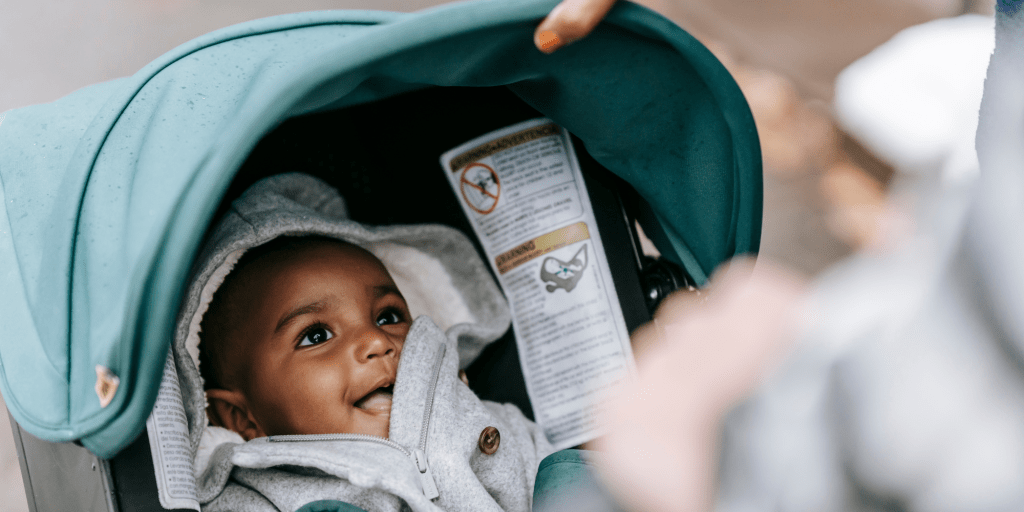
Go for a walk!
Outdoor activities don’t have to be complicated–taking a walk is an excellent way for your infant to explore the outdoors. If it’s safe and allowed, you can even take your stroller off-road and explore different terrain that you won’t find in the city. It’s a great way to get out of the house, let your little one see new sights, and experience all that nature has to offer!
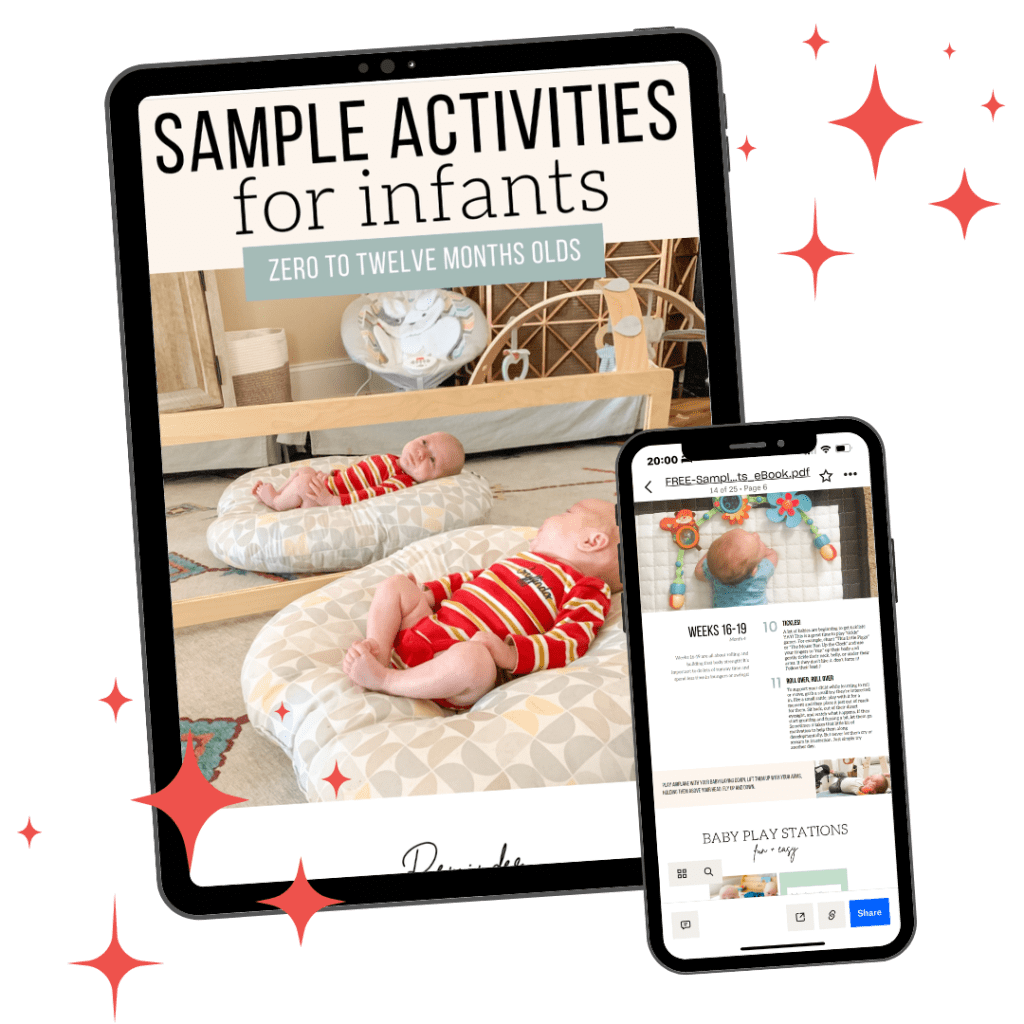
Get over 30 activities for infants delivered to your inbox.
DOWNLOAD NOW
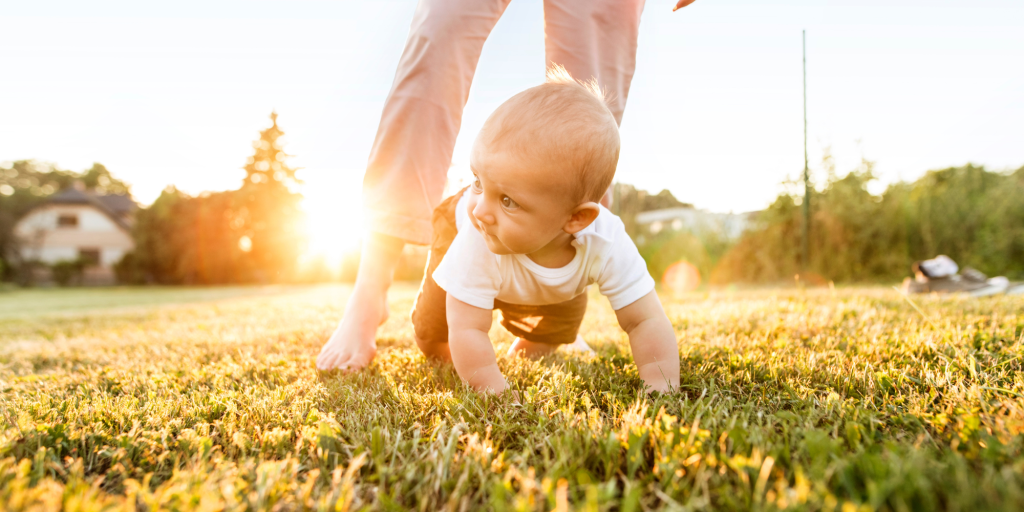
Collect Nature Objects
Exploring the great outdoors with your infant can be done in many ways. One activity is to collect natural items such as rocks, leaves, acorns, pine cones, and other found objects that you find interesting. These can later be used for art projects like painting or making impressions on paper. And collecting them has an added bonus: infants learn about shapes, textures, and colors when interacting with nature!
Observe Animals
Taking your infant outdoors for some fresh air also provides an excellent opportunity to observe animals in their natural habitats. Point out the different types of birds and small animals you see and explain how they live and what they eat. This will help your infant learn ecology early while introducing them to all nature offers.
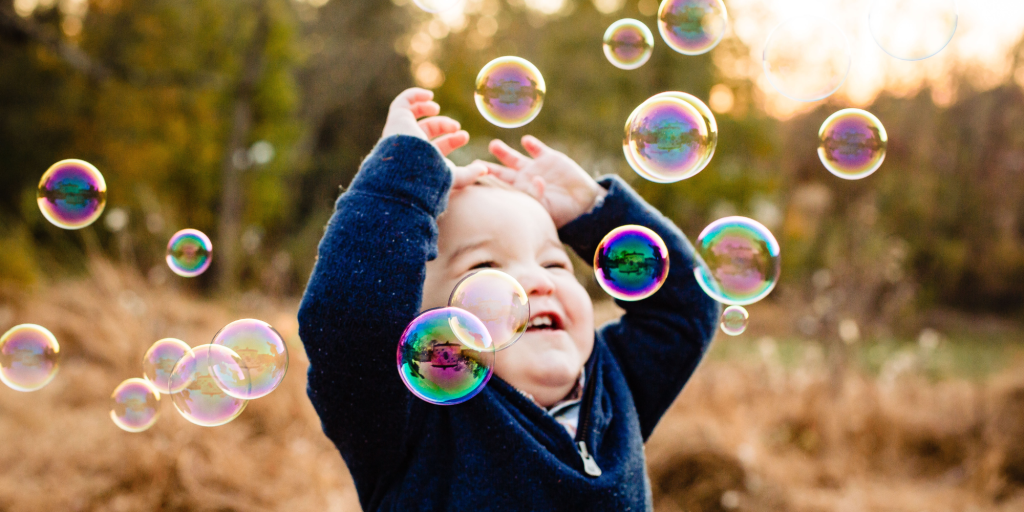
Bubble Fun
Introduce your infant to the exciting world of bubbles! Blow a few in their direction, then laugh as they reach up to catch them. This activity helps develop hand-eye coordination while adding a fun and lighthearted element to their day. Consider investing in a bubble wand or two if you want to make more bubbles!
Fingerpainting in the Sandbox
Infants love to explore their environment through touch and creative activities. Set up a sandbox and give them access to finger paints. Using their hands, they can create all sorts of masterpieces as they learn to express themselves in new ways. As an added bonus, when the paintings are done, you can bury them and start the next day anew!
Spending time outdoors with your infants can be both enjoyable and beneficial. From taking a family walk to playing at the park, there are many different activities that you can do with infants that help to promote physical health, cognitive development, emotional growth, and language development. Grab your free list of activities to support your infant and have fun supporting them!
When your children are just babies getting outside should be easy. Don’t overstress and plan. Remember, simply sitting in the grass and feeling the breeze ruffle their hair is exciting enough for them. Instead, use this time to get yourself comfortable with bringing them outside. Figure out how to go for walks and do it regularly.
Creating a routine helps set the standard for your child as they grow into the more adventuresome toddler years and you’ll be more likely to continue heading out with your littles if you’ve gotten comfortable with the process already.
You don’t need any fancy gear and you don’t need to organize nature activities. Instead, let your baby’s eyes, ears, hands, and feet do all the work.
Exploring nature with babies can be a simple as you make it. A walk around the block, a blanket on the grass, a visit to the neighbor’s garden. The important thing is to just get outside and start.
Other posts you’ll want to read:
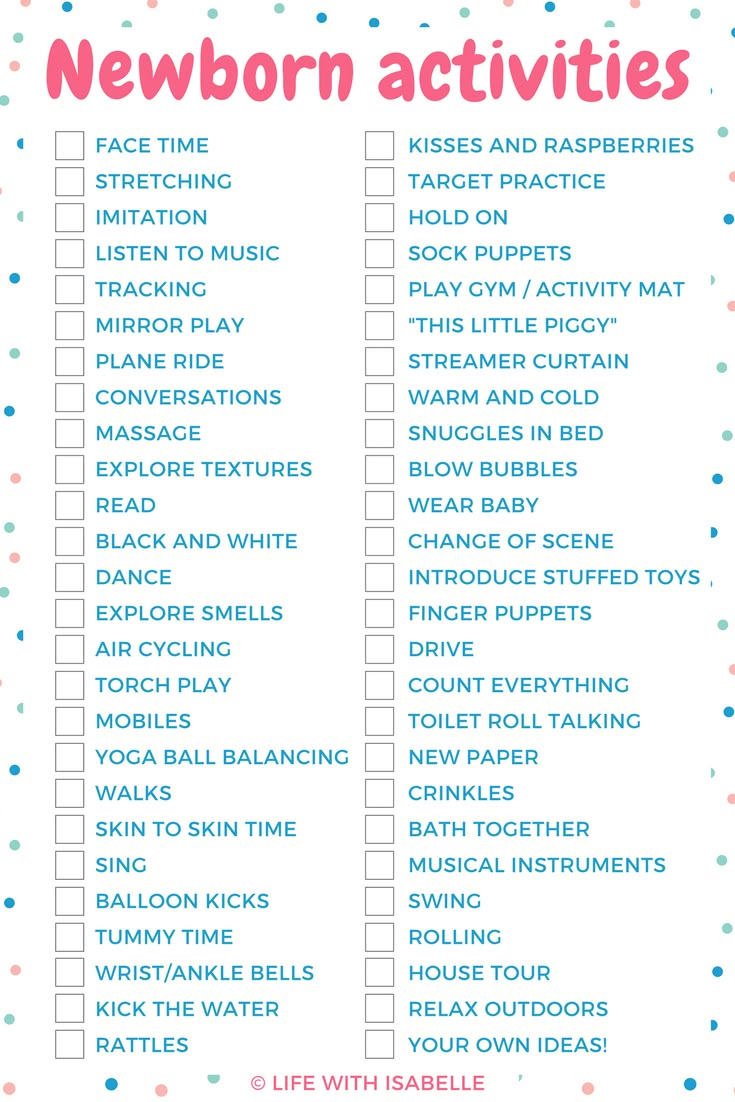
A Bucket List for Baby’s First Summer
It is your first summer with a sweet little bundle of love. And, it is your baby’s first summer – ever. Make the most of it with memorable moments and photo-worthy fun in the sun. Here are 14 more things to add to your summertime bucket list
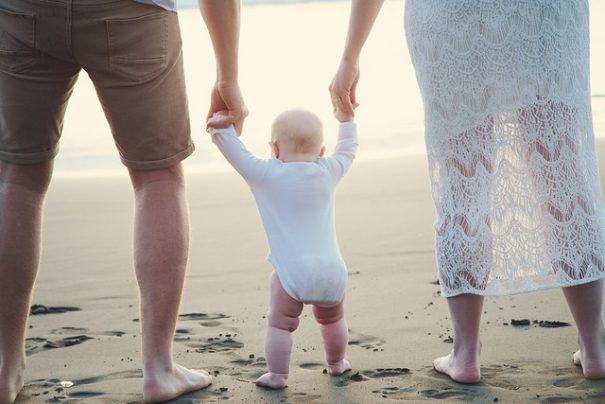
Beach Baby Walking
Taking your baby to the beach is at the top of any list of summertime fun. While you’re there, dip his toes in the water. Take advantage of the picture-perfect surroundings: draw your little one’s name in the sand and snap a shot of your wee babe with the massive ocean behind him.
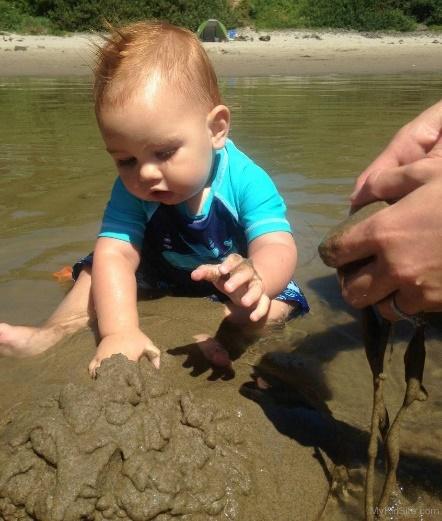
Get Messy
Do not be afraid to get messy with your little explorer. She’s never squished sand between her hands before, she’s never made a mud pie and she’s never splashed to her heart’s content at a water table. Each one creates its own mess, but we promise that will be topped by the amount of delight it creates as well.
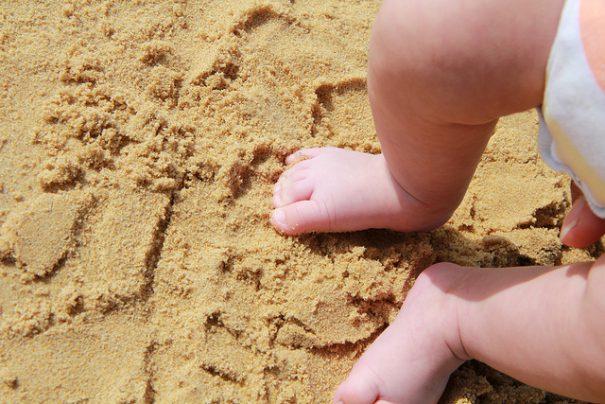
Photo: Raelene Gutierrez via Flickr
Footprint Time
Summer is the perfect time to take photos of sweet baby toes and hands before they get big. If you’re at the beach, snap a picture of your kiddo’s footprints in the sand. If you’re landlocked, dip your kiddo’s hands and feet in water, then help him make a print on warm pavement, then grab a snap a photo before it dries.
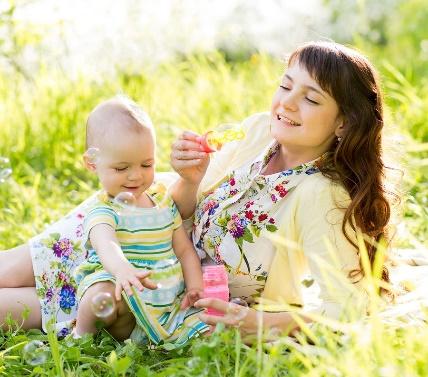
Blowing Bubbles
Spend an afternoon daydreaming and watching bubbles float on the breezes. This is a super-cheap way to mesmerize your little one, and bring on adorable, amazed expressions that make for perfect photos. It’s so easy to just keep small jars of bubbles on hand and lay out a blanket and watch them drift of. It makes an ordinary day a little special.
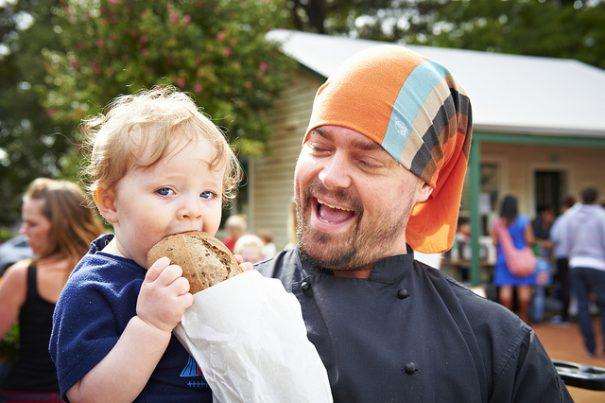
Photo: Margaret River via Flickr
Shop Together
Visit your local farmers market to pick out the freshest goodies you can find and set up a summertime feast for your new nibbler. Or, if you’re near a farm, bring the baby to a pick-your-own berries spot, where he can lounge in the shade while you grab a few bright red fruits for him to test. This site will help you find the farm nearest you.
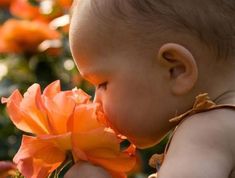
“Smell the Roses”
Head outside to take advantage of the chance for brain-boosting sensory fun in the sun: tickle your little one’s toes with a soft dandelion and let her feel a pinecone’s bumps. Listen to the buzz of a bumblebee. Taste a fresh smoothie. Walk and talk in a garden or two, describing the plants including every sense that you can.
Enjoy a lovely, lazy summer day. (Hope and Donavan were watering and “tending” their babysitters garden at a really young age. They did not have good aim but loved to hold the hose. Hope did not like water in her eyes, so we used sunglasses.)
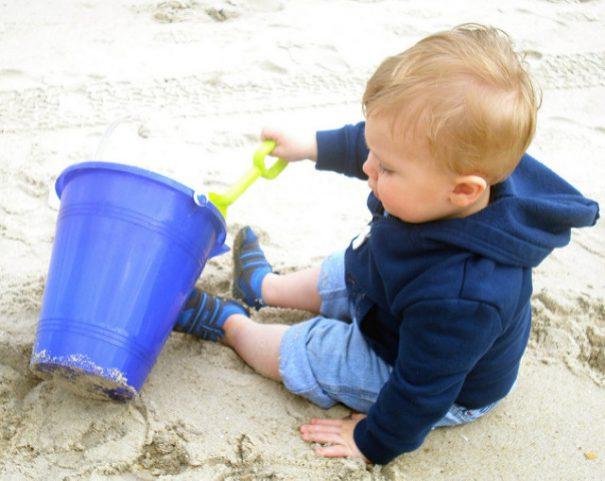
Photo: Kate Hopper via Flickr
Dig It
Pick up a shovel and a bucket and let your kiddo work on his eye-hand coordination. He can dig in the sand at the beach, scoop up some water, or shovel at the playground. Afterward, stroll by a local construction site for a little free baby-friendly entertainment show put on by diggers and cranes.
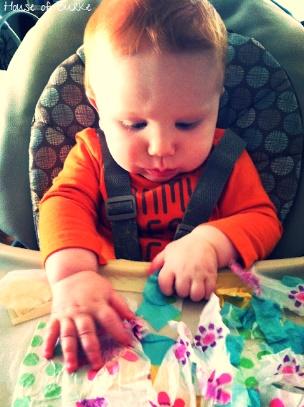
Photo By: House of Burke
Artsy Adventures
Give your baby some finger-paint (like the non-toxic kind) and let her make her first piece of artwork. When the weather is warm, simply strip your little one down to his diaper, spread old towels outside, and put out paper and a little paint. You can whip up your own easy-peasy edible finger paint with plain yogurt and a few drops of food coloring, or follow oursimple flour recipe.
Hope's first art was so simple. She loved to slap the table or tray on her highchair. So I put dabs of finger paint on a sheet of paper, index card, or paper plate and she slapped it, making spat art. She loved it.
(Using baby safe homemade paint allows you to start art so much earlier. I usually tell people. “If they can feed themselves, I can get all sorts of art out of them.” But sometimes the untamed motions they make with their hands lend themselves to making art even before that.)Alternatively, try ice painting with this how-to from Domestic Mommyhood for another fun sensory playexperience. Bonus: the mess stays outside plus you’ll have the baby's first masterpiece.
Outdoor Activities for Babies
& Parents -Together
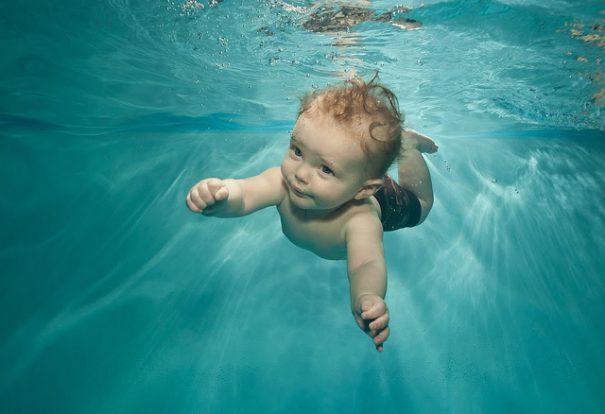
photo: Jade Alexandra Allen via Flickr
Water Baby
Pool, ocean, or bathtub: anyplace you can let your little one relax and splash, do it. Summer is the perfect time for Baby’s first swim and to sign up for a mommy-and-me swim class.
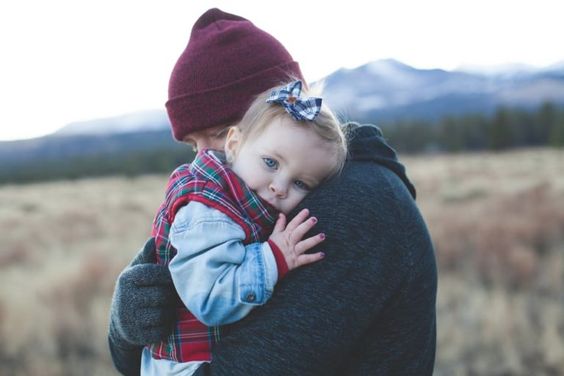
Photo: Shannon McGee via Flickr
Chill Out
When the mercury soars past 95, keep cool with indoor fun. Visit the local library to peruse their extensive selection of board books, or check out museums with stroller- and crawler-friendly programs.

Feast Outside
Whether she’s feasting al fresco on breast milk or solid food, take that food outside for your baby’s first picnic. Afterward, spread out on your blanket for tummy time under blue skies and watch the clouds drift by before nap time.
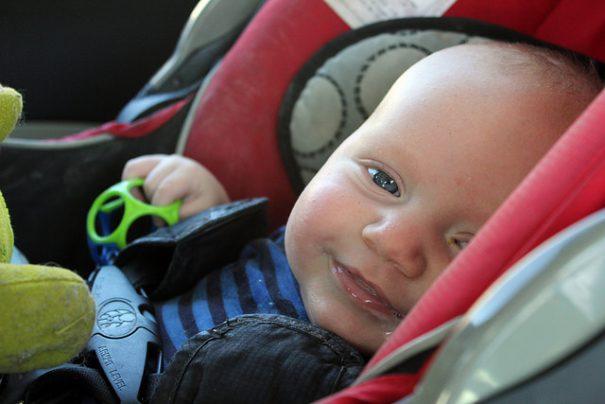
Photo: Quinn Dombrowski via Flickr
First Road Trip
Show your baby the sights by taking your first vacation together, even if it is just to the next town over. Visit a new park, stroll down unfamiliar streets and take pictures of your kiddo as you explore new surroundings together. If you’re taking a long road trip, check out this list of tips to make it a little easier on your little one – and you.
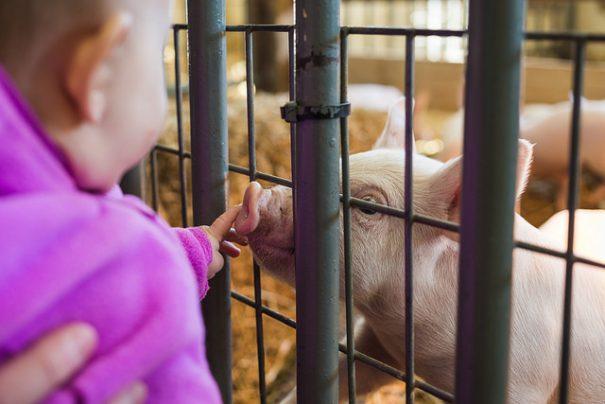
Photo: AllieKF via Flickr
Meet-and-Greet with Animals
Visit some wildlife: at a big zoo, a local petting zoo or even the neighborhood dog park. You just might meet your baby’s new best friend.
(Okay wildlife came to us in our yard. But our zoo was fabulous in Denver)
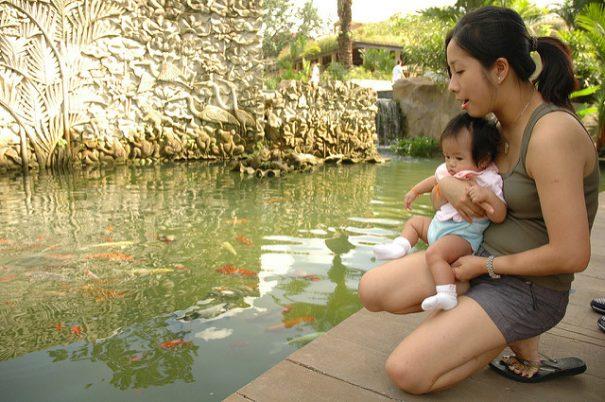
Photo: Jereme Wong via Flickr
How Does Your Garden Grow
Gardens are in bloom in the summer, and a stroll through your local botanic gardens will give you a little fresh air and show your baby all-new sights and smells. They’re blooming with sensory experiences for your baby to explore while riding high in a wrap or baby carrier.
There are so many “buzzwords” when it comes to play and learning in early childhood. However, I don’t think there is just one correct way to play. You can play your own way.
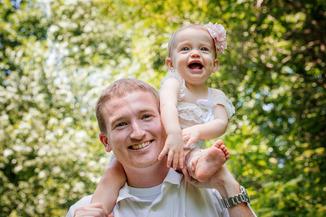
Tips and ideas for outdoor play with your baby
Outdoor Sensory play for babies simply means to involve your senses (think touch, taste, smell, etc).
The park, the beach (or sandbox), and your backyard are all packed full of possibilities for sensory play. We live in an apartment but that doesn’t stop us from using the small patch of grass that’s next to our parking lot. Babies don’t require a large space.
Here are simple tips for a nature walk or stroll:
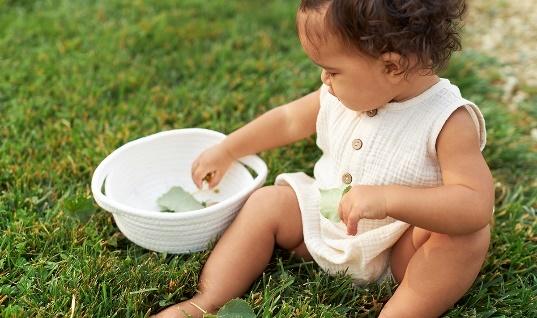
Allow your baby to get close to the ground and examine natural details—different types of grass, bark, moss, leaves, stones, pinecones, and soil may catch their attention. Collect one of each item into a container or basket.
Hunt around for some bugs! Talk about which insects crawl and which one’s fly.
Look up at the sky and tell your baby about the weather and how it makes you feel (physically and emotionally).
Trees are full of lessons—help your baby feel the texture of the trunk by placing your hand over theirs and run them along the bark and count the other trees around you together.
Practice sniffing scents of flowers, grass, fruits, or berries in a garden if you have one.
If your child likes you to take photographs or create art outside, this is a great time to have them capture some of their observations for their Adventure Journal of the critter or other pond features such as plant life or the ripples on the water’s surface.
Keep it simple, allow for child focused play, allow for them to find what they want to be enthralled in. Everything is new and their curiosity is boundless. Your job is simple: to observe and keep them safe.
Exploring Nature With Your Baby

Flowers, plants, and animals provide your little one
with rich learning opportunities.
From the first hour of life, when a baby stares into the eyes of his new parents, he is learning all about this brave new world. Babies try to make sense of what they see, touch, taste, grab, hear, hold, and squeeze. Think of a baby clutching a hunk of ripe banana, slowly squeezing it, and watching in wonder as the yellow, creamy fruit slithers between his fingers.
Babies are born primed to learn how the world of people and objects works. That is why they love exploring their outdoor surroundings. Every bug, animal, or bird that your baby sees is a brand-new experience — especially because babies spend so much time indoors. When at the park or in your yard, don't be surprised if your baby wants to touch a nice earthworm as she inspects the grass at the edge of her blanket. Many babies love to feel a caterpillar crawling on their arms.
Natural experiences should come in doses that are understandable for your baby and in ways that keep your baby safe, of course. Babies are forever exploring, whether trying to poke a finger into an electrical socket or attempting to tip over a stand so that they can pull at and maybe taste the shiny green leaves of a plant.
Babies are often unaware of dangers, and toddlers can climb with agility and fearlessness into hazardous situations. Be aware of the way your baby or toddler thinks. You might have a very gentle cat, but many a young toddler has pulled a cat's tail and received a strong scratch from the indignant cat! Social skills, such as decentering (taking the point of view of another) to consider the feelings of a peer or a kitty, are in short supply in infancy.
You might be surprised at how encounters in nature bring out a toddler's gentleness. Some will cry if you squash a Japanese beetle underfoot after you've seen the damage that beetle did to your rosebush leaves. Others will cry and protest if you clip the driveway bushes that are overhanging and scratching your car. Little children believe that moving things are alive. The bushes move and dance with the wind; your toddler thinks that maybe they are alive just as he is alive. Little children need a long time to learn about living and about death.
Opportunities to experience nature up close stimulate infant senses, provide loveliness for him to appreciate, and encourage you to label objects — flowers, plants, and animals — and to explain their characteristics. The following suggestions provide great ways for you and your child to safely experience the outdoors and will lead to rich learning experiences.
Observe animals in their natural habitat.
As you walk with your baby in a pack on your back, point out sounds she can listen to, such as a bird chirping or crow cawing at the top of a tree. Point out the insects crawling, the doggies running around sniffing, and the squirrels climbing up trees. As your baby begins to use some language, she may call your attention to a bird flying up and settling on a tree branch. Rejoice with her excitement. The world of animals and birds is a new kind of discovery for her.
Encourage touching.
In the park, you can introduce your baby to a great variety of nature's textures. Invite him to feel the grass and pinecones; to touch smooth, bumpy, and grainy textures.
Talk about the weather.
Lure your little one to a window to notice light raindrops, driving rain, and the way thunder rolls and booms after you see a jagged lightning streak. Encourage her to listen to the wind make its howling noises as it rushes by. If there is a rainbow, take your toddler outside to see this awesome arc in the sky. As your child spends time outdoors, she will become a better observer of nature, including of weather patterns.
Your child might whine if she can't go out to play due to bad weather, but if you point out different patterns — of rain, lightning, hail, or hot sun — to your little one and explain that sometimes playing outside is not safe, then your child will be aware of the weather rather than think you are making up an arbitrary excuse about why she cannot go out.
Visit the zoo.
Wheel your stroller close to an exhibit and point out what your baby is looking at, whether it's a seal splashing in the water or a monkey swinging from a branch. You have been reading animal stories to your little one from early on. Now, at the zoo, he gets to see all those creatures that were in the storybooks. Let your toddler tell you that he is watching Horton the elephant lift up his trunk!
Stroll through a garden.
Flowers and plants offer your baby sensory and aesthetic pleasures. She will be sensitive to, and admiring of, the colors, sights, and sounds. Trees, flowers, and plants provide opportunities for talking about rough bark, delicate blossoms, and perfume smells. Some flowers are lovely to look at but don't have a smell when you sniff them. You can also pick up your baby to show her a butterfly nosing about to get nectar. (A butterfly bush in your garden will attract more of these beautiful "flying flowers!")
Grow plants.
Planting is a wonderful way to generate toddler enthusiasm. When you serve orange or grapefruit slices for a snack, remove the seeds for planting. Citrus fruits, including lemons, make small, lovely plants with shiny, dark green leaves. Your toddler can spoon some dirt into a disposable drinking cup and drop the seeds into the mix. Water the plant every few days and soon two little leaves will sprout. These plants grow slowly, but they are precious to watch. Your child will learn that not only can he enjoy eating the fruit, he can make a plant grow from the fruit's seeds. How empowering for him! (Note: Flowers are lovely to adorn a home, but some plants have poisonous leaves. Be sure to keep only plants that are safe for children.)
Introducing your child to all aspects of nature will help her with language development, and will give her an appreciation for the needs of other creatures and a sense of pride at helping wildlife flourish. Enjoy these experiences together!
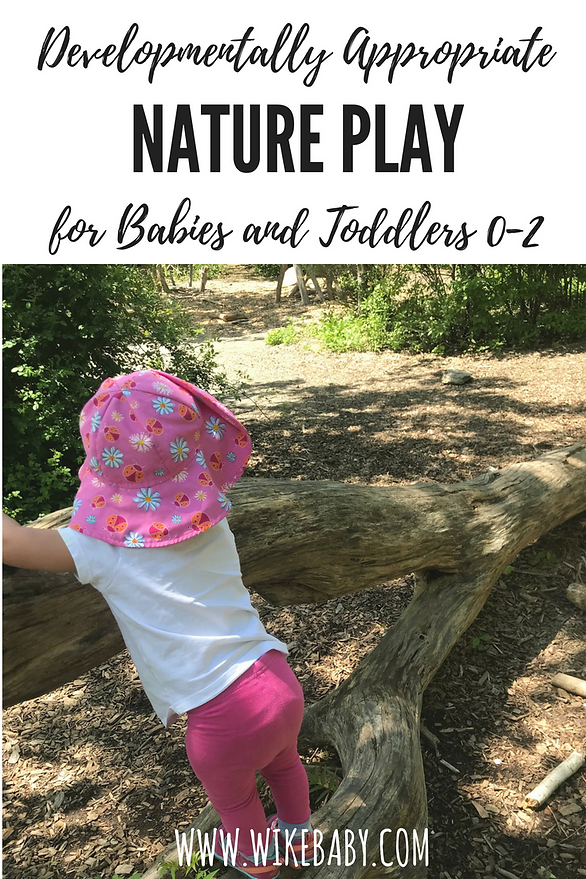
Just about one year ago, I committed to having my 5 month old play outside every day. I laid the foundation for why I feel so strongly about outdoor play and shared my ideasin a blog post about what outdoor play looks like for babies.The post provided a few ideas for what very young children can do when they are hanging around in the backyard. In full disclosure, we haven’t made it outside every single day since then, but we have made it a priority in rain, shine, or snow… and I’d say we’ve done a commendable job!
Now that my little one has grown a full year older and I’ve spend a full year thinking about, reading about, and experiencing outdoor play with young children, I have even more to share. Outdoor play is vital for all children, even the youngest of babies. Nature play synergizes the importance of active play with the benefits of a natural environment. Not only isnature play important for building physical, social, and cognitive development, it’s also a vital component for raising children who care about our Earth. Jacques Cousteau said, “People protect what they love,” and I completely agree. That’s why we needto teach children that they are a part of nature and not apart from it.
It may not seem like it, but there’s so much that even the littlest of children can do in nature. Children are never too young to begin appreciating nature nor too young to reap the benefits of spending time outdoors. Simple things like watching a bird fly through the sky nurture a baby’s development and begin fostering a love for nature.
I looked through developmental expectations for children from theCenter for Disease Control and used it to create a list of outdoor experiences for babies and young toddlers from 2 months through 2 years old. I hope this list will inspire you with at least a few ideas for nature play given your child’s development!
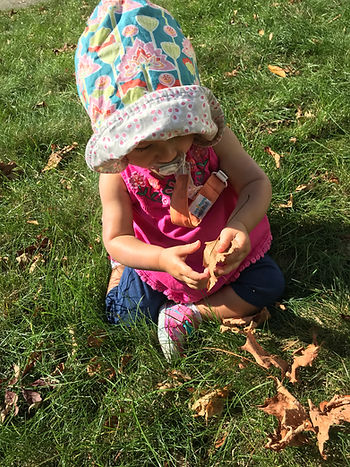
Before we move on, let's step back for a second. The purpose of this list is not to compare what your child can do to what is expected. As parents, especially new parents, it's natural for us to want to compare our child to what is "normal". I fully recognize that not all children progress through milestones at the same ages and that every child is unique. Keep in mind that even if a child's motor skills are developed age appropriately, language skills emerge at different rates. Some children showcase their oral vocabulary earlier on while others take it all in without expressing their thoughts to the world.
Children also accept sensory experiences at different rates; some can adapt quickly, while others may need a slower introduction to learn that new settings, textures, and movements are safe to enjoy. I recommend that you consult an expert such as a pediatrician, pediatric OT or PT, or speech pathologist if you have questions about your child's development.
Use this list to help you answer the question: “What can nature play look like for my baby?” Find where your child falls developmentally (regardless of the age listed), and read about what you can do to support his development during nature play.
2 Months
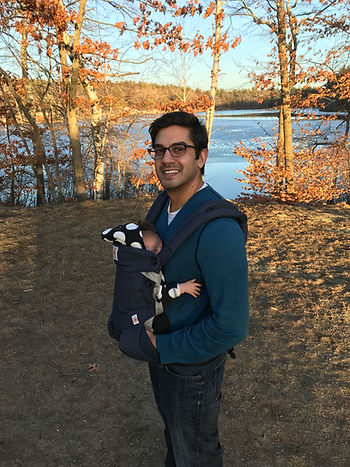
At this age, you can lay your child on a blanket outdoors. If you’re a seasoned parent or daring
(which I wasn’t when Wike Baby was this age!), try laying him on the bare ground. Put him on his back to stare up at the sky, trees, and birds, or put him on his belly with some nature items in front of him to try to view. Wear your baby in a carrier while you go for a hike or take a walk with your child while he’s nestled in his stroller.
Here’s what two month olds will generally do and what caretakers can do to support their development while outdoors:
Turns head toward sounds. Begins to follow things with eyes and recognize people at a distance. A natural setting is a great place to discover sounds-- it's quiet enough that sounds like bird calls, rustling of leaves, and running water are discernible but not overwhelming. This is also a fun age to play with light: duck in and out of shadows and watch the sun flicker through leaves or bounce off water. Everything is completely new, and watching your child discover these sensations for the first time is a beautiful thing!
Begins to act bored (fussy) if activity doesn’t change. Keep moving for a change of scenery. This is the age when Wike Baby started to LOVE being outdoors—there is so much to see, hear, and feel. Let your child feel the slight breeze on his face or the sun on his head, and let this sensation change for your child as you walk through different environments.
Can hold head up and begins to push up when lying on tummy. Try tummy time outdoors. Place nature items in front of your baby to encourage him to build those muscles. If he’s resistant, like Wike Baby was, put him on your chest as you lay down on the grass for some parent-child outdoor bonding.
4 Months
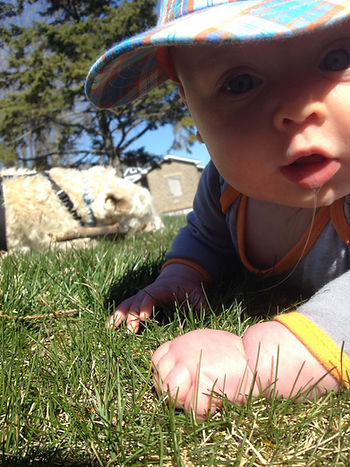
At four months or when your baby is able to hold his head up steadily (between 4-6 months
generally), your child is ready to face outward in your baby carrier, such as theErgo 360 (our favorite). We tried this around 5 months, and Wike Baby LOVED it. It’s a whole new way for them to see the world. This is also when your child can sit with assistance, such as in your lap or in a Bumbo seat. Although it is certainly not recommended by pediatric physical therapists, we used our borrowedBumbo for short periods of time, including sitting outside in our yard.
Here’s what four month olds will generally do and what caretakers can do to support their development while outdoors:
Copies sounds that are heard.
Draw attention to sounds you hear by mimicking them yourself. Name the animal that made them to help your child begin to associate language with concrete items.Uses hands and eyes together, such as seeing a toy and reaching for it.
Can hold and shake a toy. This is a particularly great time to begin to lay nature items out around your baby for him to manipulate and explore: rocks, pinecones, flowers, grass, bugs, seeds, etc. Be aware that it’s also prime time for oral exploration to begin! Pro tip: if you’re lucky/unlucky enough to have a pacifier user on your hands, pop the paci in your child’s mouth before providing him with items to explore. (That’s my two cents; feel free to let your child put items in his mouth if that’s your parenting style! Judgment-free zone over here!)Recognizes familiar people and things at a distance.
Visit the same outdoor environments frequently to build familiarity. Name the items you see, and point out some of the same things each time you visit. Point out birds, planes, and critters that make noise, and watch them as they move. Point them out and follow them. When you hear something, stop to investigate what it is. Think aloud: "What was that noise?" or "Why did that tree move?" Then, together search for it. Look for the bird that tweeted or the squirrel that rustled the leaves. This lays the foundation for encouraging curiosity!
6 Months
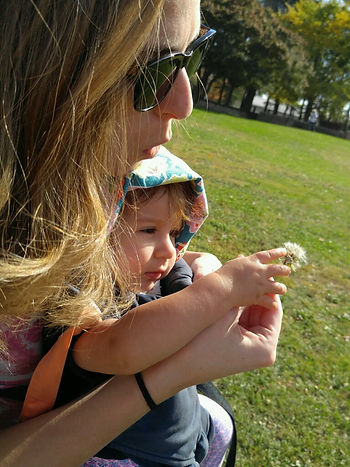
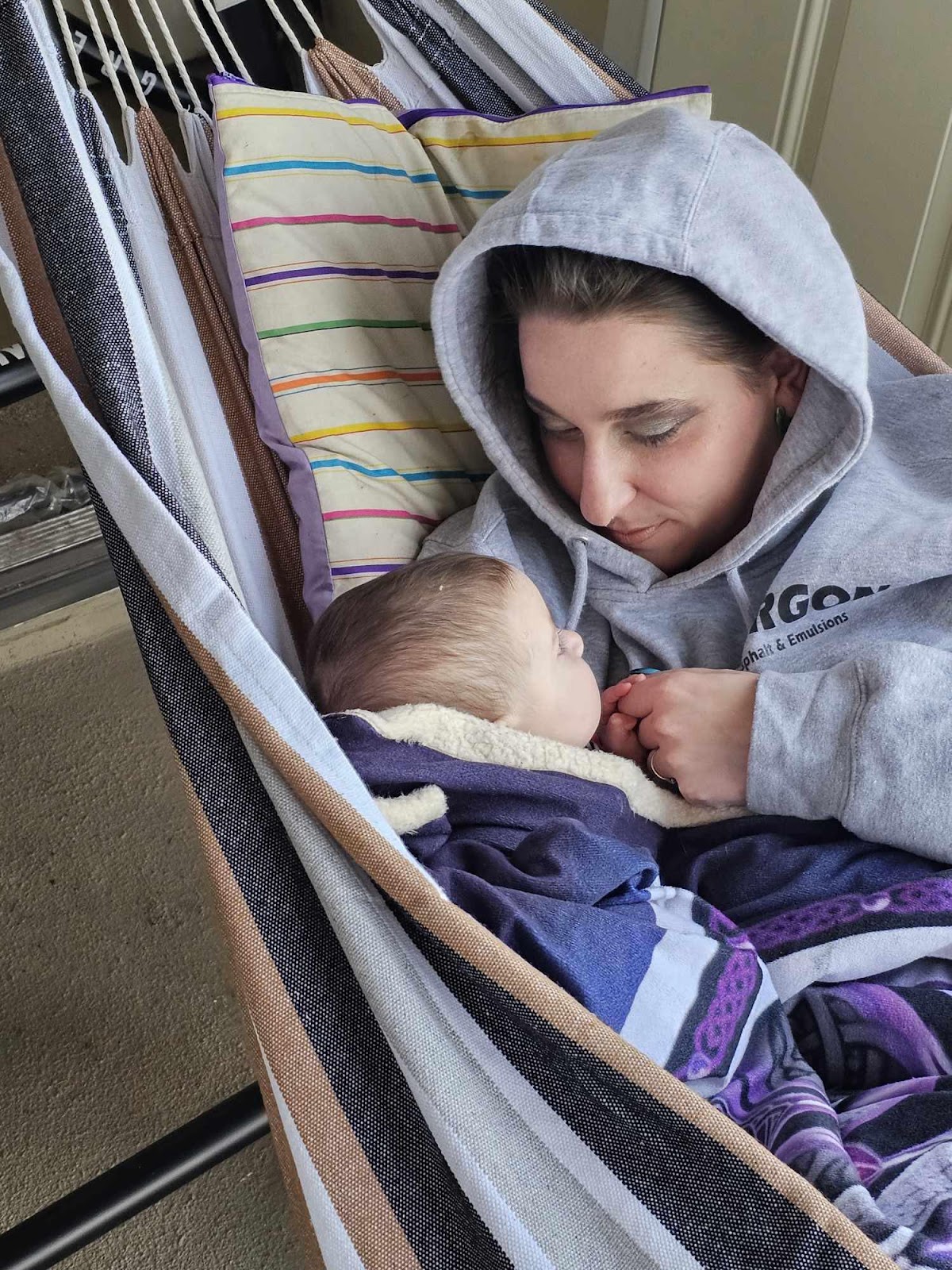
This is one of my favorite stages—your baby is becoming more and more fun! His personality is beginning to shine through, and he likes to play. Spending time outdoors together is a great way to bond, which is true at every stage, but it’s becoming even more fun for both of you at this point in your child’s development.
Here’s what six month olds will generally do and what caretakers can do to support their development while outdoors:
Likes to play with others, especially parents. Tummy time with your child on your belly while you lay on the grass, coupled with giving him an “airplane” ride (or pterodactyl ride, be creative!), can be ridiculously fun.
Responds to sounds by making sounds. Listen for nature sounds and mimic them. You may find your child mimicking them (or you), as well.
Makes sounds to show joy and displeasure.
While walking with your child forward-facing in a carrier, try doing gentle hops or twirls along the way. Spinning, even with your child attached to you in a carrier, develops your child's vestibular system, which is responsible for balance, coordination and skills like head and trunk control and rolling. Your child’s understanding of object permanence is developing, so hide behind a tree and pop out to see your friends or have them do the same to you. Bounce and sing songs. What makes your child squeal with delight? Keep doing that!Looks around at things nearby.
There is SO much to see outside. Wike Baby always calmed down outside because she was taking in everything there is to see, feel, and hear!Shows curiosity about things and tries to get things that are out of reach. When doing tummy time outside, place items just out of your child’s reach to motivate him to move.
Begins to sit without support.
Break out your bubbles! When your child can sit and likes to reach for things, blowing bubbles begins to be super fun!
9 Months
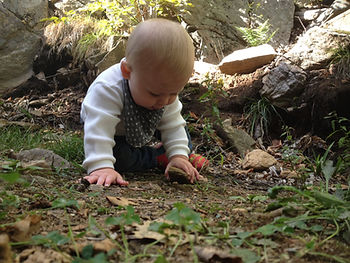
Around nine months is when your child may begin to show curiosity. In my opinion, curiosity is one of the most exciting things about childhood! Nurturing our children’s natural curiosities is one of the important things we can do for their cognitive development.
Here’s what nine month olds will generally do and what caretakers can do to support their development while outdoors:
Uses fingers to point at things.
When your child points at things while on a walk, name the item and follow his finger to get close up and touch the item (if possible). You’ll be teaching your child how to follow his curiosity.Watches the path of something as it falls.
Leaves, snow, seeds, flower petals, rain: there’s something falling from the sky in every season. Take moments of time to stop and simply watch gravity in action with your child.
Looks for things he sees you hide.
We played some epic hide ‘n’ seek with Dad behind trees while hiking at this stage. While sitting on the grass, you can also hide rocks (avoid rocks that are choking sized!) under leaves or cover items with grass or sand.Puts things in mouth.
As in everything. If you’re lucky/unlucky enough to still have a pacifier user on your hands, you can use it as a plug to keep your child from exploring nature items with his mouth. On the other hand, if you know something is safe for consumption, your child is eating table food in the home, and you know your child has no allergies, it could be a fun time to have him taste edible plants. Perhaps you’re into foraging or simply have an herb or vegetable garden. Use your discretion!Crawls, pulls to stand, sits without support, and stands holding on. Your baby is on the move! Find safe outdoor spaces for your child to practice these skills. Remember that “clean dirt” (soil without chemicals) is healthy and comes off in the bath! This is also a time when your child may begin to play with push toys—why not bring them outside?
1 Year Old
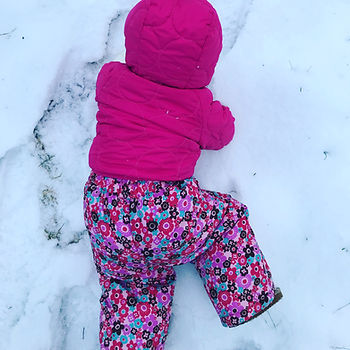
At one year, your child increasingly interacts with the world around him. Hopefully he is stronger now, so you can be outside experiencing the elements in rain, shine, or even snow. If you haven’t yet put your baby on your back while walking about or hiking, definitely try it now. At one year, Wike Baby loved being on my back while snowshoeing, and she especially loved being pulled in a sled on the snow. This is also the time when your child may begin to be even more mobile; embrace it, and let him build his skills on the varying terrain outdoors.
Here’s what one year olds will generally do and what caretakers can do to support their development while outdoors:
Explores things different ways, like shaking, banging and throwing. While hiking with your child on your back, pass things such as dandelions, cattails, or sticks back to your baby to hold and explore. Stand along the shore together and toss rocks in to the water. Show your child how two sticks or two rocks knock together to make a sound.
Looks at the right picture when it’s named. If you’ve been naming what you see outdoors since he was tiny, now he may be able to find an item (such as a flower or bird) when you say the word. Vocalize interesting things you see using the name (such as, “Look at the beautiful flower!” or “Do you see the pretty bird?” without pointing, and follow your child’s gaze as he interprets your words.
Puts things in a container, takes things out of a container. Wike Baby happily did this for hours on end. Bring a small bucket or bag with you on your outdoor adventure. When you locate a place with rocks or small sticks, show your child how to put them into the bucket. Watch as he then takes them out and puts them back in again. Over. And over. And over again!
Pokes with index finger.
Encourage this! Poking at trees and feeling their different types of bark can be an interesting sensory experience for a one year old. Build oral language by naming the textures he feels.Pulls up to stand.
May take a few steps on own. May stand alone. As soon as your child starts to crawl and walk, let him experience different terrain. Walking on grass, sand, or snow outside is much different from the hardwood floors inside. You cannot replicate outdoor terrain indoors, and the outdoor terrain will help your child naturally develop balance, core strength, and spatial awareness. Allowing your child to walk outdoors without shoes is a physical and occupational therapist suggested activity that supports your child's development of balance, sensory processing, and proper muscle development in the feet.
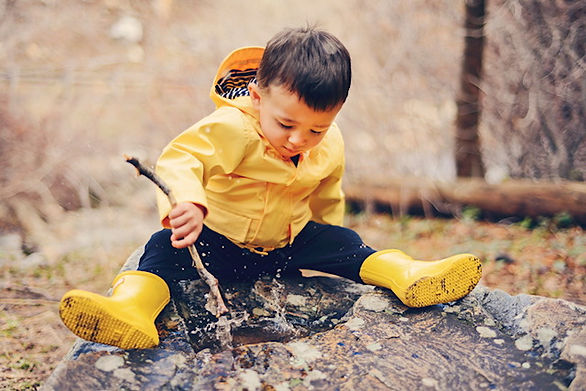
18 Months

This is just about where Wike Baby is right now, and let me tell you how fun she is at this stage! She is able to engage herself in free outdoor play, she loves to climb, and she’s beginning imaginative play. She wants to walk on her own, but we don’t get too far while hiking because her goals are different from mine. At 18 months, letting your child take the lead outdoors should be priority number one.
Here’s what eighteen month olds will generally do and what caretakers can do to support their development while outdoors:
Likes to hand things to others as play. Let your child explore nature items he comes across. When he hands something to you, such as a stick, thank him, hold it, and hand it back. Engage in play by handing him things you find as well. As always, name the items with which you interact in full sentences to promote language growth.
Follows 1-step verbal commands without gestures. Practice this when you get ready to go outside by telling your child to get his socks. Then tell him to get his shoes. Then tell him to get his jacket. When you’re outdoors, there’s plenty of opportunity to use 1-step commands during play. “May I have the stick please?” “Walk over here.” “Look at that bird!”
Plays simple pretend, such as feeding a doll.
This can be a good time to bring out the mud kitchen! You can fashion one yourself using old wood pallets, visit a nature play area or even a sandbox nearby, or simply bring some bowls and spoons outside for playtime. Finding nature items to put into your concoction is part of the fun. Remember that this is also the age when children follow 1-step demands, so be mindful if you stir up a beautiful dish of sand, crushed leaves, and grass and you say, “This is delicious! Try it!” Your child may actually take a taste! Not that I know from experience…Explores alone but with parent close by.
I can get so much yard work done now! She happily plays in the sandbox, picks up sticks around the yard, or goes down the slide on her own—as long as I’m nearby. I put a fort out in the yard for her to play in, and she loves bringing things inside, sitting in there for a while, and then coming out for more things. I know someone with a child this age who actually reads a book under a tree while her son plays on his own. Milk it, Mama.
Says several single words. Engage in conversation every time he says a word that corresponds with what he sees in order to encourage his language. If he points to a bird and uses the word, then tell him all about the bird, its colors, and what it is doing. Engage. Encourage.
Scribbles on own. Time to introduce sidewalk chalk! Sidewalk chalk is endless fun. On hot days, you can also “paint” on pavement with water and watch it disappear. Show your child how some rocks can be used to write on other rocks. We had a blast writing with shale when I was a child.
Walks alone. May walk up steps and run. Let your child take lead on “hikes”. I put “hikes” in quotation marks because you should set your expectations accordingly. You will not be traveling far with an 18 month old taking the lead. Wike Baby likes to go in the opposite direction of my goal. That’s fine. Embrace it. This is also a good time to encourage safe climbing. Climbing stairs, fallen logs, or natural rock formations is a worthy obstacle for an 18 month old.
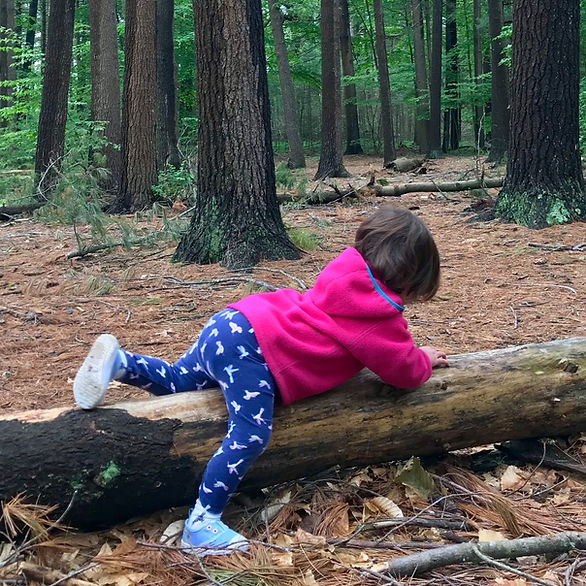
2 Years Old
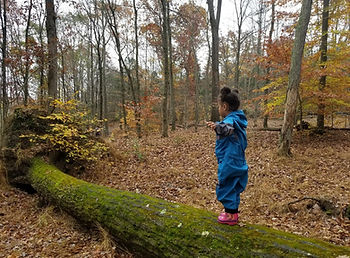
This is where we are headed in my house, and boy do I have ideas. I’ve consulted friends with two year olds or recent two year olds to ensure my suggestions are appropriate. I welcome your ideas, as well! Share them in the comments below.
Here’s what two year olds will generally do and what caretakers can do to support their development while outdoors:
Copies others, especially adults and older children.
Playing in nature with other children (especially older children) will give your child lots of ideas of things to do. This is the perfect age to start attending a mixed age nature play group near you, such as Free Forest School!Points to things or pictures when they are named.
When you see something interesting, tell your child. Don’t point to it, necessarily. You can foster language development this way by saying things like, “Let’s run to the big rock.” “Where is the red bird?” or “I see a gigantic puddle!”Finds things even when hidden under two or three covers. Playing in sandboxes is a great experience to introduce now if you haven’t already done so. You can hide nature items like pinecones, flowers, and rocks in your sandbox and have your child find them. If you’re feeling particularly "Pinterest-y," there are tons of similar sandbox activities out there to try. For example, you can make “fossils” with plaster of Paris, hide them in your sandbox, and give your little paleontologist a shovel, paintbrush, and magnifying glass to help him excavate.
Begins to sort shapes and colors.
There is so much to sort outside: leaves, rocks, sticks, and flowers are just a start. Use small bags or buckets for sorting or simply draw circles with chalk for a spot to place the items. When hiking, hunt for specific things like big pinecones and small pinecones. Support your child’s language of colors by naming the colors of things all around you—including the trail markers! We love to high-five all the “yellow dots” along our favorite trail.Plays simple make-believe games.
A twig might become a phone, a rock may become a steering wheel, you might pretend to fall asleep outside on a comfortable looking boulder. Engaging in imaginative play with your child is one of the finest things in life.Builds towers of 4 or more blocks. Try building towers of flat rocks together or take your blocks outside. You can also cut wood for an outdoor block set or create a Waldorf-inspired block set like the one onthis blog post.
Follows two-step instructions. Practice two-step directions when you’re getting ready to go outside. Say, “Get your shoes and jacket, so we can go outside.” When you’re out and about, there’s plenty of ways to practice this. “Give the big stick and the little stick to Daddy,” for example.
Names items in a picture book. It doesn’t have to be in a book; at this age, children can name some items they see in general, such as after you hike to the top of a mountain and look out. That being said, reading is SUCH an important experience for young children to have, and I would be remiss if I didn’t use this opportunity to encourage reading! Bring your books outside, especially your nature books. Bring your bookSome Bugs by Angela DiTerlizzi outdoors while you explore and capture insect, or bringOver and Under the Pond by Kate Messner to the lake with you and see what you can find that matches the book. Bringing your books outside can really make nonfiction come to life!
Stands on tiptoe. Kicks a ball. Begins to run. Climbs onto and down from furniture without help. Walks up and down stairs holding on. Again, you cannot replicate outdoor terrain indoors. Even playgrounds do not give your child the opportunities for physical challenge that natural settings provide. Let your child climb on rocks, trek through puddles, roll down hills, and balance on logs. The natural terrain will help your child naturally develop balance, core strength, and spatial awareness
Throws ball overhand. If you haven't yet taught your child the pleasure of throwing rocks into giant bodies of water, now is the time. Big splashes are encouraged!
Some of the ideas I shared are super simple and some are more complex. Maybe just knowing that the simple things you’re doing outside with your baby matter and are contributing their development will support your efforts to get outside. Your child is never too young to start appreciating nature and never too young to reap the benefits of being outdoors!
Which ideas have you already tried? What is this list missing? What will you try tomorrow when you’re outdoors with your child?
Ways to Bring Nature Inside
Let them help be a part of the whole process of collecting and assembling and then investigating nature inside your home.
Nature Sensory Bottles
These were a real treat in our house. Simply choose which sense you’re going to activate and fill small clear jars with either flowers (sight), herbs (smell), grains (hearing) or anything that will surprise your little one! I used empty spice jars or plastic jars from Dollar Tree. The grains were a big hit as they made lovely gentle sounds, which she preferred over loud, synthetic commercial ones. I used smaller spice jars when the kids were babies. Fill bottles with water and your natural treasures and tighten the cap securely.
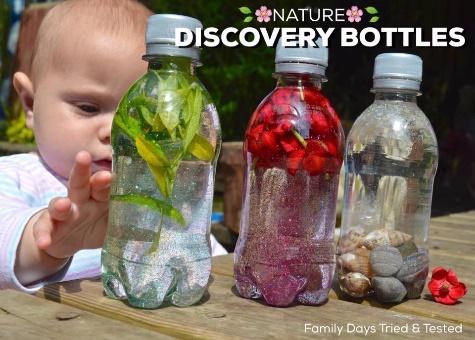
Simply trim the stem off a few flowers as tight as you can to the bud then run them through the laminator (or press them in a heavy book for a few days then use clear contact paper folded over the flowers. I cut all my sheets to the same size to make it easier for children to sort through. She really enjoyed studying each little bud and leaf.
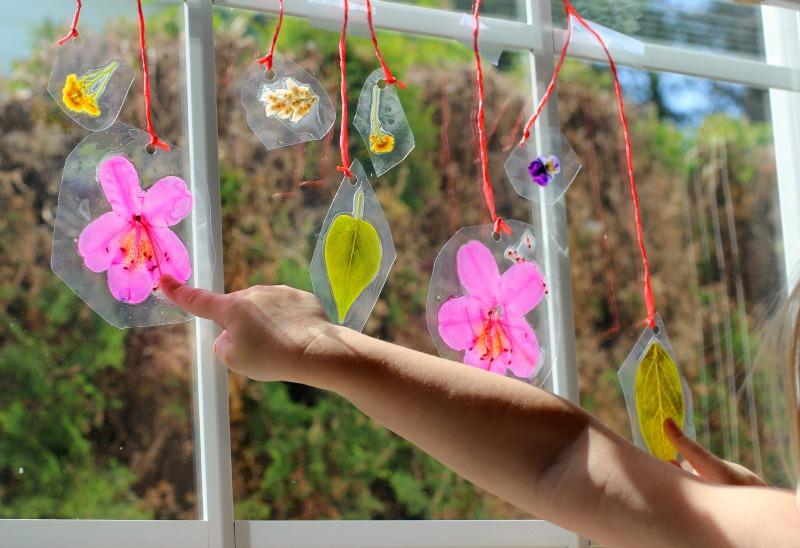
The girls made theirs into asuncatcher garland & loved exploring the flowers with magnifying glasses and comparing the flowers and leaves. Beautiful right? I love spring crafts because they bring so much color into the house!
Baby Nature Blocks
Hope was a happy baby who loves simple games like that (as do most babies. Blinking lights and flashy toys are really not necessary!)

But sometimes mama just wants to get crafty and make a new toy for baby. I did that today with a grocery store bouquet of flowers and some upcycled baby food containers!
How to Make Baby Nature Blocks
First off, this is going to be the easiest toy to make! I barely need to make a “how to” section on this post. But I know how much some of you like details, so here goes:
Supplies:
Flowers (I used a grocery store bouquet) or other nature
Baby food containers (Gerber’s plastic ones work well)
After the food containers were empty and had been washed, I just placed a few flowers and leaves inside of them and snapped the lid back on. That’s it. The hardest part of this whole activity is having flowers on hand.
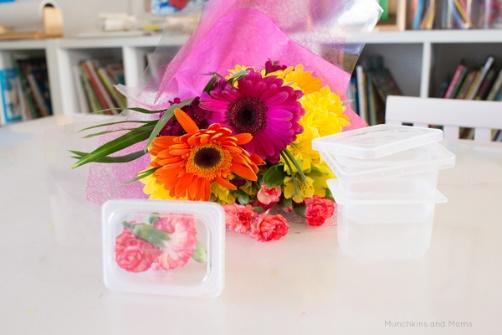
The next step was introducing them to baby. He was soooo happy! He knocked over every tower I made, threw them across his mat, investigated them from all angles, banged them together, etc.
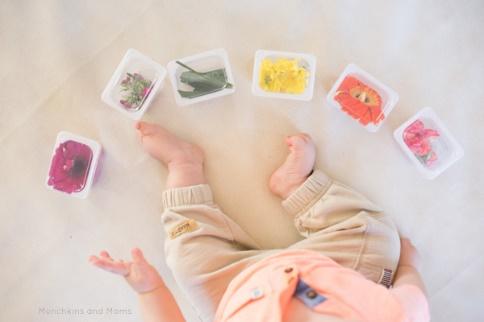
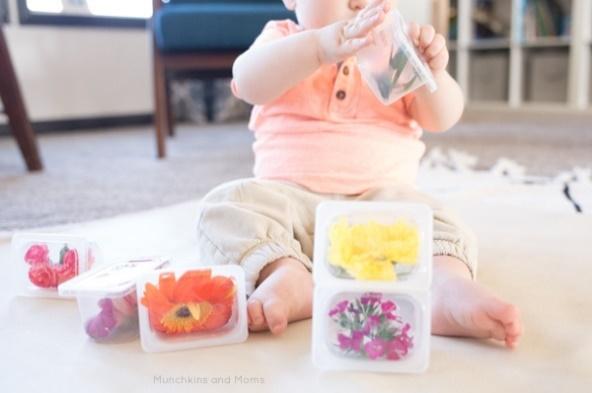
These blocks are so inviting! The way the light shone through them, the vibrant colors of the flowers, and the way the petals gently swished as he shook them made them extra intriguing for our little one <3
I know some of you will ask how long these blocks keep for. The truth is I don’t know. We just made them yesterday, so I’ll test them out and update you all later.
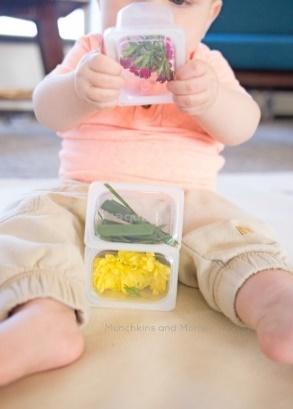
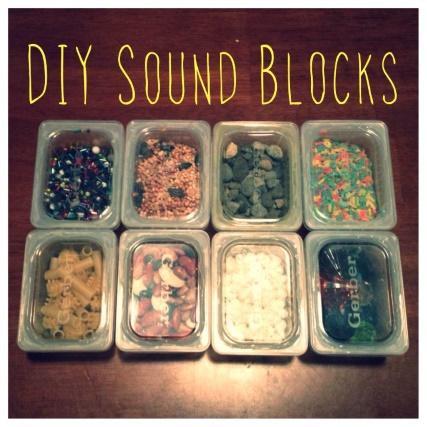
Sound blocks can be made with the same process. The eight sound blocks I made were filled with nature, rice, beans, pasta, birdseed, shells, pea gravel, beads, and colored gems. You could use any materials you have on hand though that you feel would make a neat noise when shaken. I think next I’d like to make one with bells inside!
Nature Sticky Mural
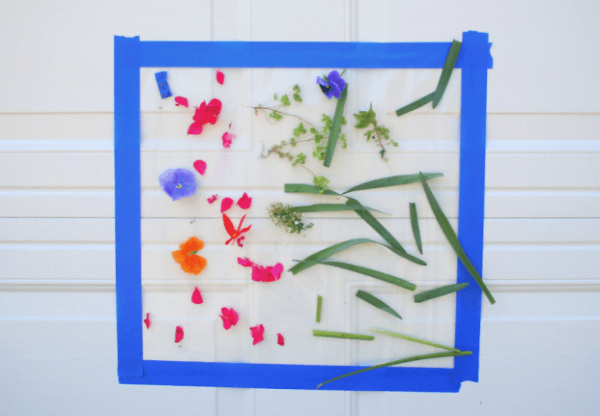
Nature is art, and you can also create your own custom art with elements from nature! I can Teach my Child has a lovely idea for an outdoor mural where toddlers can stick leaves, petals and whole flowers in any pattern of their choice. You’ll need contact paper for this activity, which you can stick to a wall or solid gate outside. Hand the children the materials and let them create art!
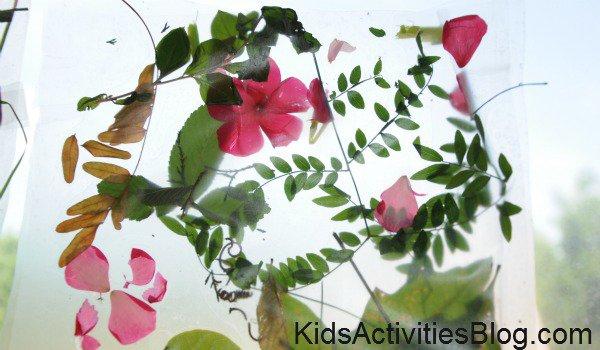
Collages are among the easiest craft projects for toddlers and preschoolers, and this one from Kids Activities Blog is no different! However, what’s special here is that you use only natural elements to make the collage! They have used contact paper to make the collage do double duty as a sun catcher, but you can just use a sheet of thick paper or card stock as well. Use fresh flowers or dried ones – they’ll all look pretty!
Nature Sensory Bag
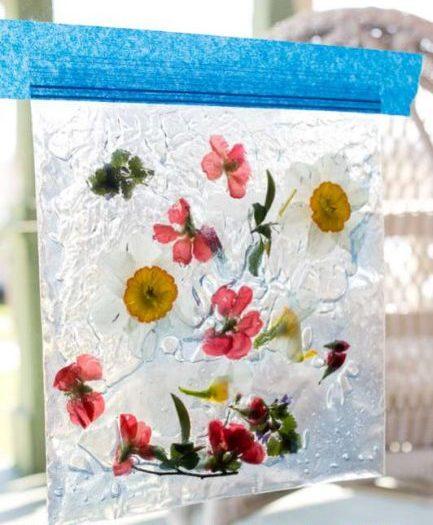
Sensory bags are a great way for babies to explore and learn to focus their attention. This sensory bag from Hands On as We Grow also doubles as a sun catcher – just stick it on window! Gather the materials by doing a scavenger hunt or a nature walk and use double bags especially if you’re dealing with over-excited toddlers or babies! You can focus on using different textures here, so it’s more fun to squish and move around!
Scent Jars
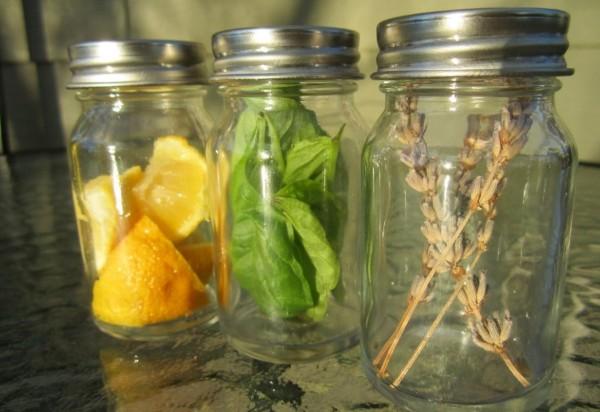
This is an excellent sensory activity for toddlers and preschoolers and helps them learn about different scents. Mamas Happy Hive has used lavender, lemon and basil, but you can use any scent of your choice. Just use clean, dry glass jars, add a piece of lime or a spring of lavender along with the associated essential oil. Hand the jars to your child and let him sniff and guess!

Sensory bottles are a great option for babies and toddlers, and we love this one from Rhythms of Play! The best part is that you can make it with things lying in and around your house. Get a transparent plastic bottle so kids can see all the components even while they’re shaking and playing with their rainstick. With the rains coming soon, let them get used to the sound of falling raindrops!
Nature Soup
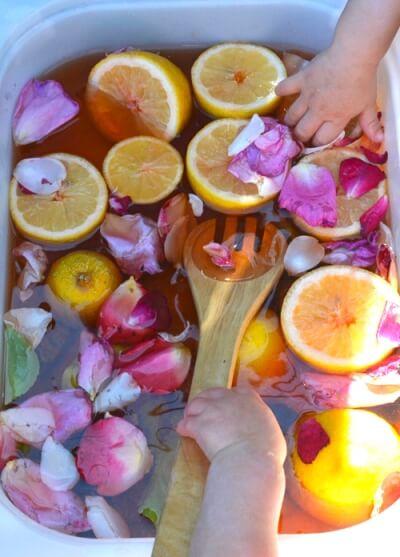
Who doesn’t love water play? We bet your little one does and that’s why she’ll love this nature soup activity from Meri Cherry! This is basically a water based sensory activity, where you create a ‘soup’ with all kinds of elements – lemons, leaves, flowers, twigs and more! Put it all into a large plastic tub with colored water, and then hand them utensils and brushes to swish everything through. Let them stir, sieve and pour to their heart’s content!
Tying Wild flower or herb bouquet
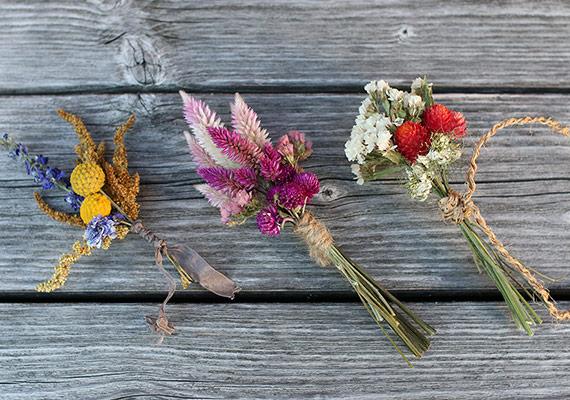
Preserving herbs and Flowers from your walks and adventures.
Hand drying, the oldest method, is also the easiest and most effective method for drying anything: leaves, flowers or herbs. Hang drying is also good for drying large quantities. You can tie and hang dry flowers in a closet, attic, dry cellar, garage, outdoor shed, or anywhere that is dry, warm and out of strong sunlight. Use for wall hangings from a stick or small branch or display in a vase.
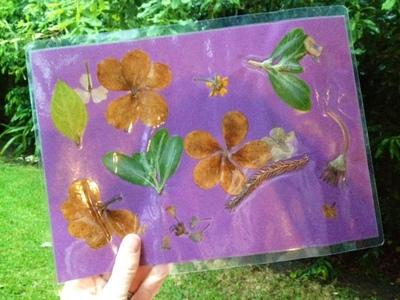
Make placemats to spread your love of nature
It could become an ideal gift for any occasion. Older children will manage this easily on their own but younger children will need help from an adult with the lamination process. It takes a week or so to dry the flowers, so you'll also need to plan to set them aside and be patient.
Montessori Parenting Tips:
Getting Outside
You know I love to be outside with my children as much as we are able. No matter the time of year, we try to be outside at least a bit throughout the day. When my kids are babies, it's so easy just to pop them on a blanket or into a carrier to get outside. It's when they move into toddler territory it's when things start to feel really tricky. Young toddlers - that is 1-year-olds - they are on the move. They climb things, they put things in their mouths, they don't necessarily listen to you right away. Getting outside with your young toddler can feel like a huge task.
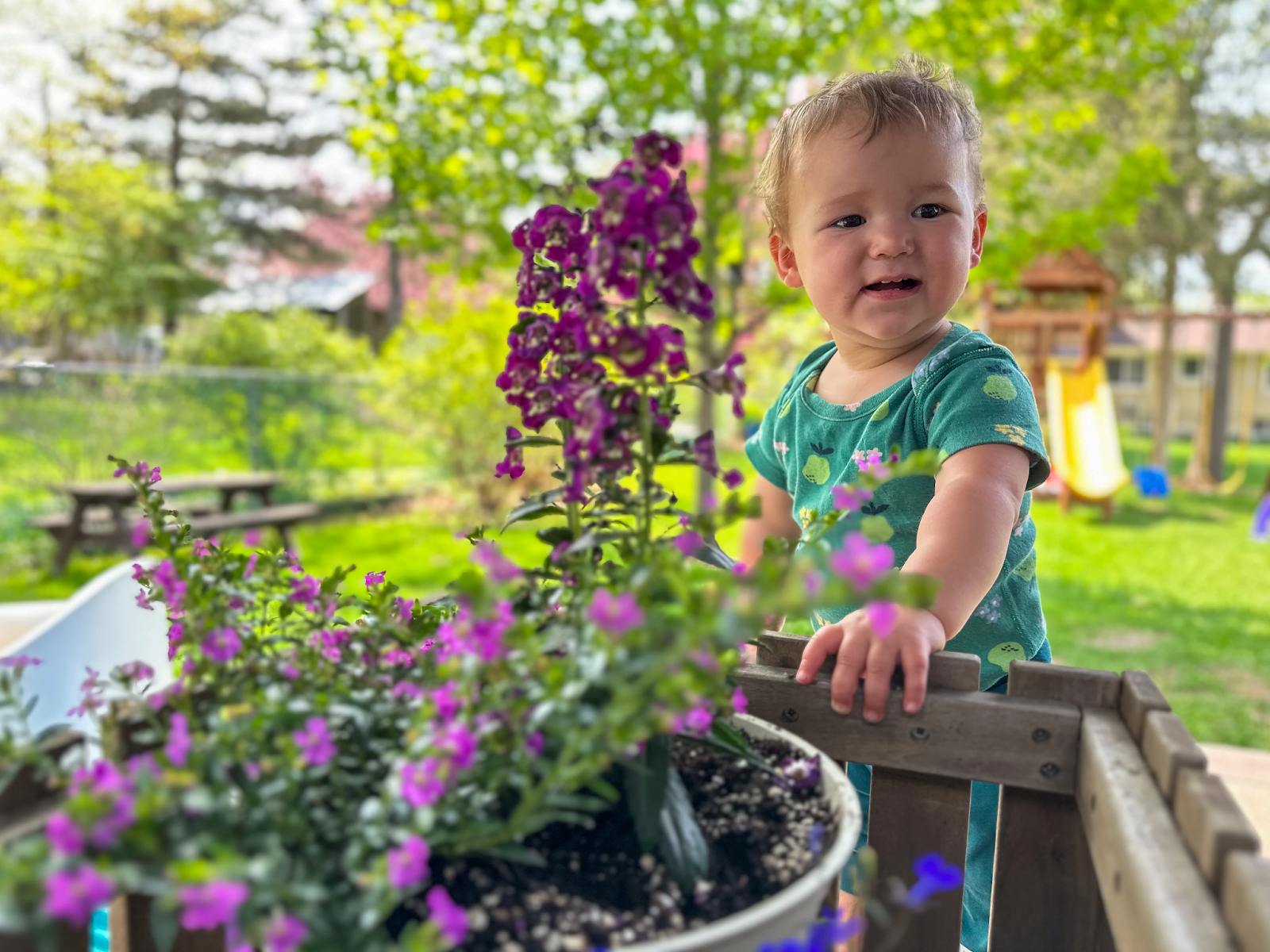
Benefits of Outdoor Play for Young Toddlers
But, let me tell you it's worth it. Young toddlers (just like babies) gain so much from being outdoors. There are opportunities for movement and incredibly rich sensory experiences. The outdoors provide opportunities for risky play, learning balance, and incredible language opportunities.
"Nature is as essential to our sensory systems as good nutrition is to our health. We need to spend time in nature to make sense of the world around us and to grow a more advanced an capable sensory motor system - the foundation for all academic skills. Therefore, it is critical that we allow our babies to spend time outdoors at an early age." Angela Hanscom, Barefoot and Balanced
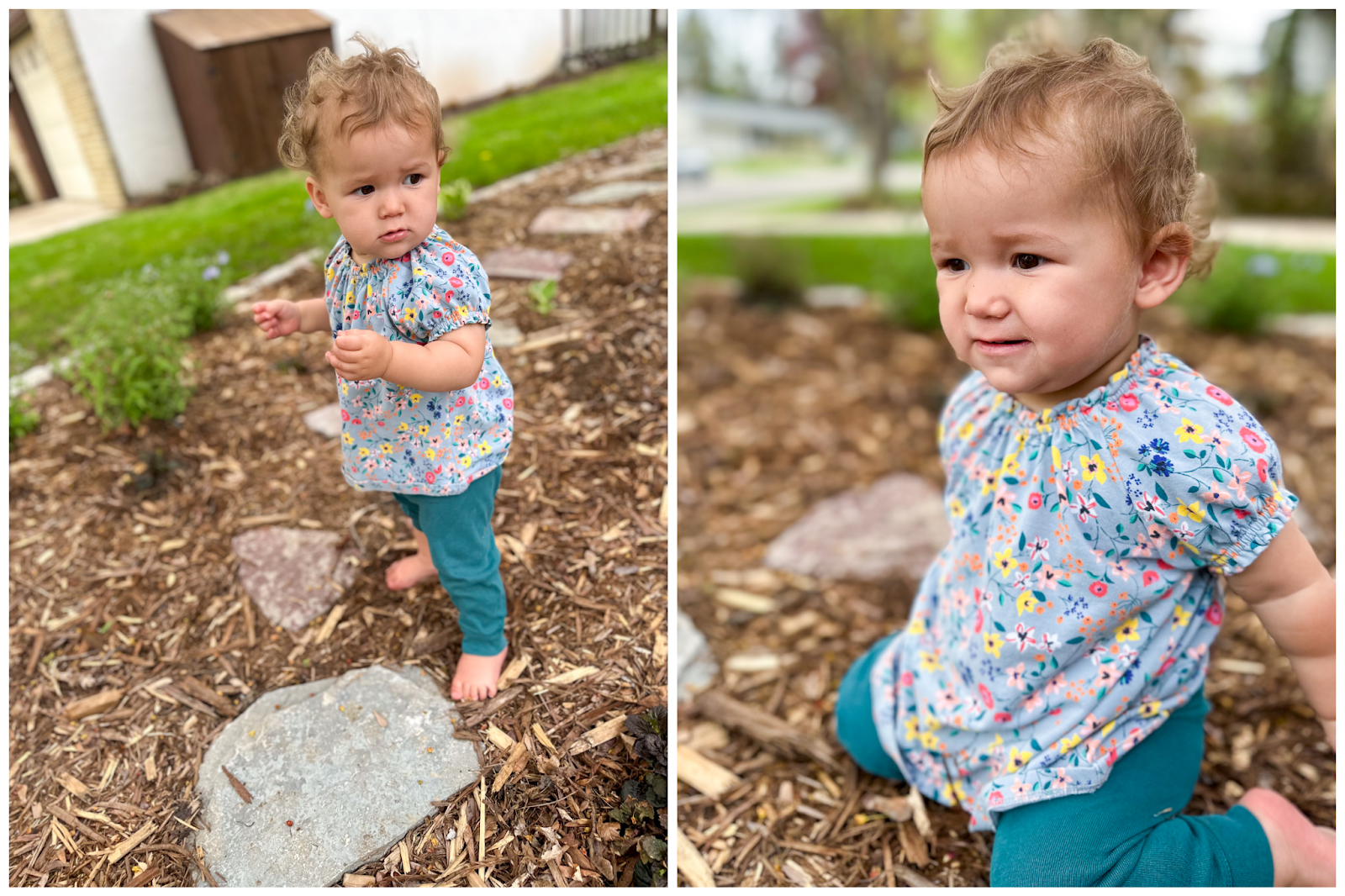
So, how can we get outside with tiny toddlers? And, with a lot of things in Montessori parenting the answer almost alway lies with being prepared.
Tips for Getting Outside with Little Ones
Here are some practical Montessori parenting tips to get you outside with your little ones.
Relax Yourself: think about any true dangers in the environment and prepare for those. Often we have been so conditioned to think that the outdoors are dangerous for babies that we don't want to allow any exploration. If you can, remove dangerous plants and animals or other hazards. But worry less about simple bumps, falls, or uneven terrain - that's all part of the amazing outdoor learning
Mouthing Will Happen: Accept that mouthing is part of their exploration. Stay close and redirect when necessary but try to not worry about eating natural items like sticks.
Dress for the Weather AND Movement: consider how well your child is able to move in the clothes that they are wearing while still staying warm or cold. The more unrestricted they can move, the safer they will be.
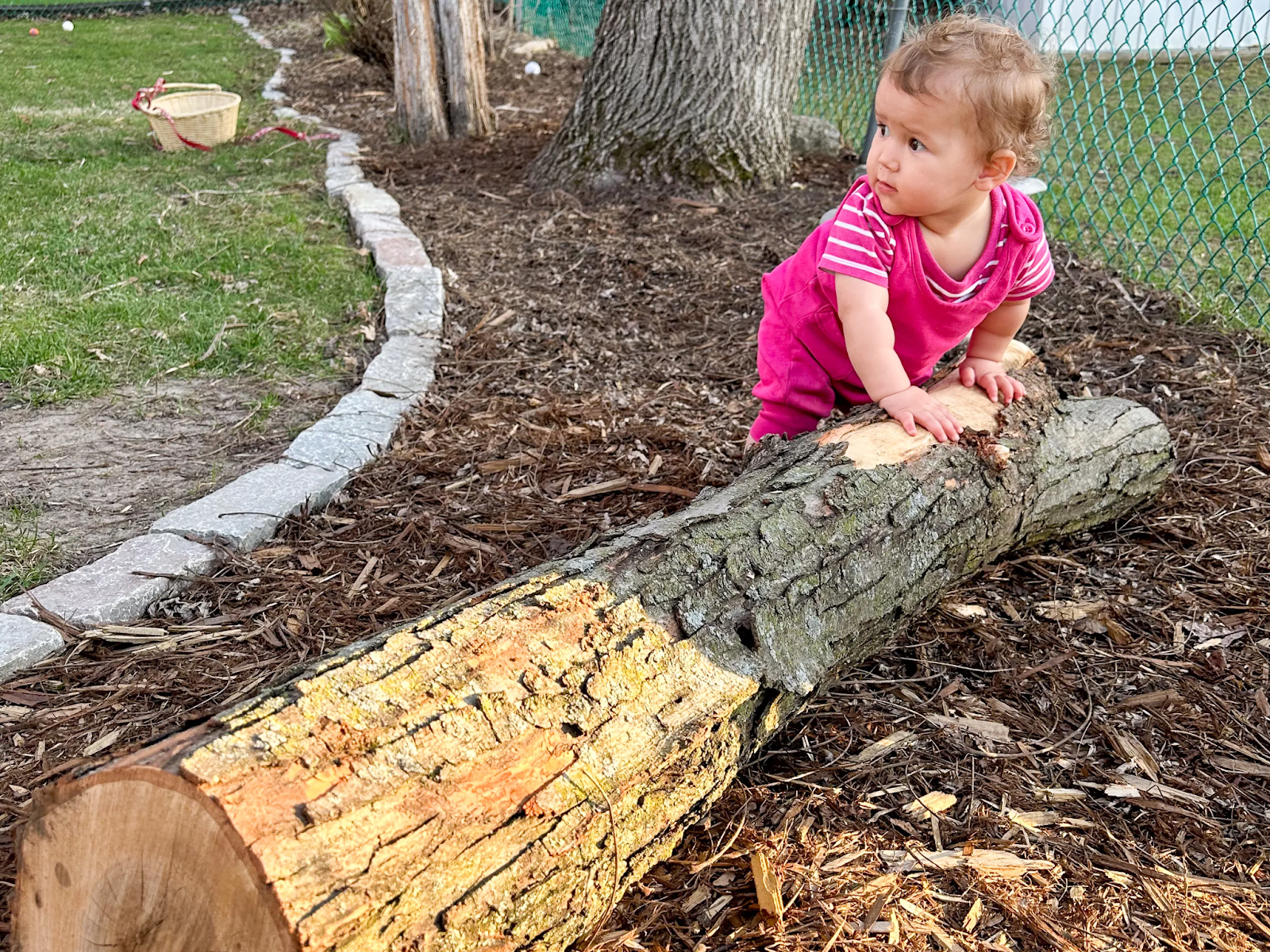
You're Not on the Entertainment Committee: If necessary stay physically close, but avoid the trap of feeling like you need to constantly engaging your toddler - that makes it harder for your child to learn to play independently as they get older. Let them find ways to entertain themselves
Add a variety of Sensory Experiences - add water, dirt, grass, plants. All of this just adds to their learning outdoors
Show them the Rules: Don't expect toddlers to understand not to pull out your plants. Instead show them how to interact with the environment. Show them where to scoop rocks, how to touch plants, where to stop beside a road. Don't rely on correction alone, make the outdoors about connection.
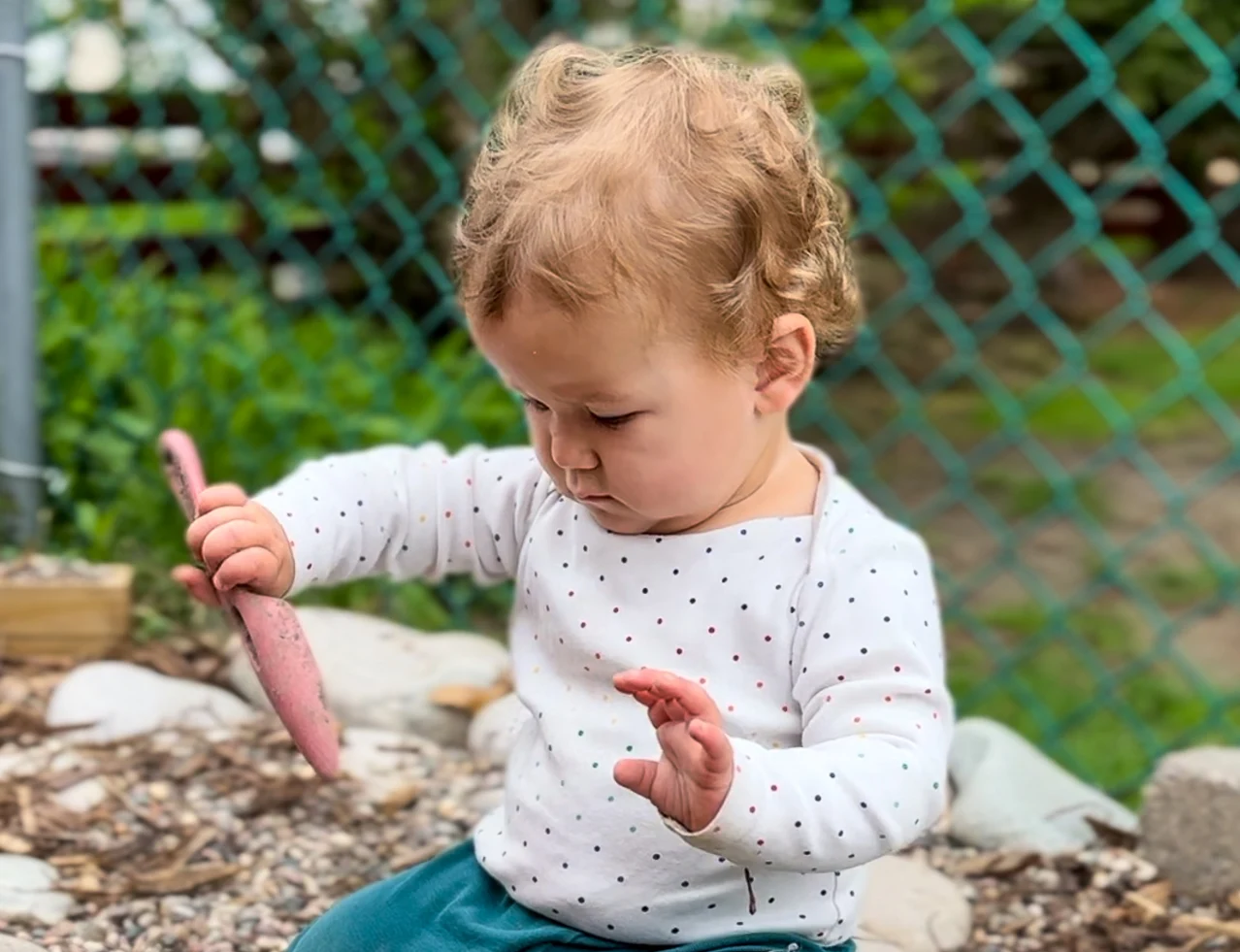
There are so many rewarding opportunities outside. Use these tips to make it a little easier for you to take your young toddler outside. The more you practice, the easier it becomes!
Nurturing With Nature
Seeing and smelling - such pleasing experiences for infants outdoors. In mild weather, be sure to push strollers to places where babies can see, touch, and smell flowering plants. They want to feel the rough bark of a tree, the soft brush of wild grasses or grains of sand, and explore the many textures of large stones and rocks. You can guide this sensory journey as you help them to notice their natural surroundings, like the gently swaying leaves in a summery tree.
If possible, consider landscaping your outdoors with a flowering hedge of perfumed jasmine to delight babies' sense of smell. And on a warm summer day, babies who sit well relish the experience of a shallow wading pool, where they can splash in a few inches of water while you cheer on their discovery of wet versus dry. Be sure babies wear hats and have sunscreen on exposed skin.
Animals
If you can arrange to wheel strollers to a pond, be sure to bring food for the ducks. Babies love to be part of the ritual of feeding ducks (and fish too). One 10-month-old, whose visits to the duck pond were such a pleasurable part of daily outdoor excursions, said "duck" as her first Word! If there are flocks of birds that visit a grassy space near your program, babies will also delight in watching them swirl down to peck at seeds you've scattered for them.
Physical Development
Lawns and other safe outdoor spaces are wonderful places to set babies down on their stomachs so they can observe from close range ants busy crawling, grass moving, grasshoppers leaping, buttercups all yellow and dainty. This arrangement will also give babies opportunities to push up from their bellies and strengthen their arm muscles. Be sure to bring along wet wipes, as babies love to squeeze dirt in their fingers. At the same time, you can help them understand that they may squeeze, touch, and sniff but may not eat many of the earthy materials outdoors.
Urban Spaces
Even a stroll to mail a letter can be an adventure! Lift up baby so he can drop your letter into the slot. And be sure to point out interesting events along the way: "See the doggy sniffing near that fire hydrant?" "See the light turn green at the corner? Now all the cars know they can go zoom, zoom along the street." "Hear the siren wailing as the fire truck rushes to put out a fire?" The sights and sounds of an urban landscape provide so many opportunities for using new words with little ones. You'll see sights together and speak the words, such as truck or car or green light or bus, that babies will have seen and pointed to in picture books.
Sandboxes
Outdoor play in a large sandbox is a delightful sensory experience for very young children. Sandboxes invite babies to use their fingers and hands and, at the same time, to begin to learn simple rules, such as "The sand stays inside the sandbox." Infants develop dexterity while filling and emptying pails or sifting sand with a flour sifter. They learn how sand feels dry and how it feels wet, when mixed with water. And, of great importance, they get a chance to play peacefully next to peers. This companionable side-by-side play is the precursor to more interactive play older babies will come to enjoy.